Advances in Metal-Organic Frameworks MIL-101(Cr)
Abstract
:1. Introduction
2. Synthesis of MIL-101(Cr)
2.1. Hydrothermal Synthesis Method
2.1.1. Traditional Hydrothermal Method
2.1.2. Microwave-Assisted Hydrothermal Method
2.1.3. Template Hydrothermal Method
2.2. Solvothermal Method
3. Applications
3.1. Adsorption
3.1.1. Gas Adsorption
3.1.2. Dye Adsorption
3.1.3. Drug Adsorption
3.1.4. Other Adsorption Applications
3.2. Catalysis
3.2.1. Oxidation of Olefins and Aromatic Heterocycles
3.2.2. Esterification and Acylation Reactions
3.2.3. CO2 Cycloaddition Reaction
3.2.4. Acetal and Condensation Reactions
3.2.5. Coupling Reaction
3.2.6. Cyanosilylation and Hydroxyalkylation Reaction
3.3. Other Applications
3.3.1. Drug Delivery
3.3.2. Sensors
3.3.3. Proton Conduction
3.3.4. Hybrid Matrix Membranes
4. Conclusions
Author Contributions
Funding
Conflicts of Interest
References
- Kitagawa, S.; Kitaura, R.; Noro, S. Functional porous coordination polymers. Angew. Chem. Int. Ed. 2004, 43, 2334–2375. [Google Scholar] [CrossRef]
- Long, J.R.; Yaghi, O.M. The pervasive chemistry of metal-organic frameworks. Chem. Soc. Rev. 2009, 38, 1213–1214. [Google Scholar] [CrossRef]
- Rosi, N.L.; Eckert, J.; Eddaoudi, M.; Vodak, D.T.; Kim, J.; O’Keeffe, M.; Yaghi, O.M. Hydrogen storage in microporous metal-organic frameworks. Science 2003, 300, 1127–1129. [Google Scholar] [CrossRef] [PubMed] [Green Version]
- Jiang, H.L.; Xu, Q. Porous metal-organic frameworks as platforms for functional applications. Chem. Commun. 2011, 47, 3351–3370. [Google Scholar] [CrossRef]
- Sakata, Y.; Furukawa, S.; Kondo, M.; Hirai, K.; Horike, N.; Takashima, Y.; Uehara, H.; Louvain, N.; Meilikhov, M.; Tsuruoka, T.; et al. Shape-memory nanopores induced in coordination frameworks by crystal downsizing. Science 2013, 339, 193–196. [Google Scholar] [CrossRef] [PubMed]
- Furukawa, H.; Ko, N.; Go, Y.B.; Aratani, N.; Choi, S.B.; Choi, E.; Yazaydin, A.O.; Snurr, R.Q.; O’Keeffe, M.; Kim, J.; et al. Ultrahigh porosity in metal-organic frameworks. Science 2010, 329, 424–428. [Google Scholar] [CrossRef] [PubMed] [Green Version]
- Farha, O.K.; Yazaydin, A.O.; Eryazici, I.; Malliakas, C.D.; Hauser, B.G.; Kanatzidis, M.G.; Nguyen, S.T.; Snurr, R.Q.; Hupp, J.T. De novo synthesis of a metal-organic framework material featuring ultrahigh surface area and gas storage capacities. Nat. Chem. 2010, 2, 944–948. [Google Scholar] [CrossRef] [PubMed]
- Yulia, F.; Nasruddin; Zulys, A.; Ruliandini, R. Metal-Organic Framework Based Chromium Terephthalate (MIL-101 Cr) Growth for Carbon Dioxide Capture: A Review. J. Adv. Res. Fluid Mech. Therm. Sci. 2019, 57, 158–174. [Google Scholar]
- Murray, L.J.; Dinca, M.; Long, J.R. Hydrogen storage in metal-organic frameworks. Chem. Soc. Rev. 2009, 38, 1294–1314. [Google Scholar] [CrossRef]
- Zhao, X.; Xiao, B.; Fletcher, A.J.; Thomas, K.M.; Bradshaw, D.; Rosseinsky, M.J. Hysteretic adsorption and desorption of hydrogen by nanoporous metal-organic frameworks. Science 2004, 306, 1012–1015. [Google Scholar] [CrossRef] [Green Version]
- Yanai, N.; Kitayama, K.; Hijikata, Y.; Sato, H.; Matsuda, R.; Kubota, Y.; Takata, M.; Mizuno, M.; Uemura, T.; Kitagawa, S. Gas detection by structural variations of fluorescent guest molecules in a flexible porous coordination polymer. Nat. Mater. 2011, 10, 787–793. [Google Scholar] [CrossRef] [PubMed]
- Achmann, S.; Hagen, G.; Kita, J.; Malkowsky, I.M.; Kiener, C.; Moos, R. Metal-organic frameworks for sensing applications in the gas phase. Sensors 2009, 9, 1574–1589. [Google Scholar] [CrossRef] [PubMed] [Green Version]
- Yamada, T.; Otsubo, K.; Makiura, R.; Kitagawa, H. Designer coordination polymers: Dimensional crossover architectures and proton conduction. Chem. Soc. Rev. 2013, 42, 6655–6669. [Google Scholar] [CrossRef] [PubMed]
- Sadakiyo, M.; Okawa, H.; Shigematsu, A.; Ohba, M.; Yamada, T.; Kitagawa, H. Promotion of low-humidity proton conduction by controlling hydrophilicity in layered metal-organic frameworks. J. Am. Chem. Soc. 2012, 134, 5472–5475. [Google Scholar] [CrossRef]
- Horcajada, P.; Gref, R.; Baati, T.; Allan, P.K.; Maurin, G.; Couvreur, P.; Ferey, G.; Morris, R.E.; Serre, C. Metal-organic frameworks in biomedicine. Chem. Rev. 2012, 112, 1232–1268. [Google Scholar] [CrossRef]
- Taylor-Pashow, K.M.; Della Rocca, J.; Xie, Z.; Tran, S.; Lin, W. Postsynthetic modifications of iron-carboxylate nanoscale metal-organic frameworks for imaging and drug delivery. J. Am. Chem. Soc. 2009, 131, 14261–14263. [Google Scholar] [CrossRef] [Green Version]
- Sun, J.; Yu, G.; Huo, Q.; Kan, Q.; Guan, J. Epoxidation of styrene over Fe(Cr)-MIL-101 metal–organic frameworks. RSC Adv. 2014, 4, 38048. [Google Scholar] [CrossRef]
- Férey, G.; Mellot-Draznieks, D.; Serre, C.; Millange, F.; Dutour, J.; Surblé, S.; Margiolaki, I. A Chromium Terephthalate-Based Solid with Unusually Large Pore Volumes and Surface Area. Science 2005, 309, 2040–2042. [Google Scholar] [CrossRef]
- Hong, D.-Y.; Hwang, Y.K.; Serre, C.; Férey, G.; Chang, J.-S. Porous Chromium Terephthalate MIL-101 with Coordinatively Unsaturated Sites: Surface Functionalization, Encapsulation, Sorption and Catalysis. Adv. Funct. Mater. 2009, 19, 1537–1552. [Google Scholar] [CrossRef]
- Li, G.; He, X.; Yin, F.; Chen, B.; Yin, H. Co-Fe/MIL-101(Cr) hybrid catalysts: Preparation and their electrocatalysis in oxygen reduction reaction. Int. J. Hydrogen Energy 2019, 44, 11754–11764. [Google Scholar] [CrossRef]
- Tang, Y.; Yin, X.; Mu, M.; Jiang, Y.; Li, X.; Zhang, H.; Ouyang, T. Anatase TiO2@MIL-101(Cr) nanocomposite for photocatalytic degradation of bisphenol A. Colloids Surf. A Physicochem. Eng. Asp. 2020, 596, 124745. [Google Scholar] [CrossRef]
- Kavun, V.; van der Veen, M.A.; Repo, E. Selective recovery and separation of rare earth elements by organophosphorus modified MIL-101(Cr). Microporous Mesoporous Mater. 2021, 312, 110747. [Google Scholar] [CrossRef]
- Rajati, H.; Navarchian, A.H.; Rodrigue, D.; Tangestaninejad, S. Effect of immobilizing ionic liquid on amine-functionalized MIL-101(Cr) incorporated in Matrimid membranes for CO2/CH4 separation. Chem. Eng. Process.-Process Intensif. 2021, 168, 108590. [Google Scholar] [CrossRef]
- Zhao, X.; Wang, Y.; Li, J.; Huo, B.; Huang, H.; Bai, J.; Peng, Y.; Li, S.; Han, D.; Ren, S.; et al. A fluorescence aptasensor for the sensitive detection of T-2 toxin based on FRET by adjusting the surface electric potentials of UCNPs and MIL-101. Anal. Chim. Acta 2021, 1160, 338450. [Google Scholar] [CrossRef]
- Wang, Y.; Jia, M.; Wu, X.; Wang, T.; Wang, J.; Hou, X. PEG modified column MIL-101(Cr)/PVA cryogel as a sorbent in stir bar solid phase extraction for determination of non-steroidal anti-inflammatory drugs in water samples. Microchem. J. 2019, 146, 214–219. [Google Scholar] [CrossRef]
- Sheikh Alivand, M.; Hossein Tehrani, N.H.M.; Shafiei-alavijeh, M.; Rashidi, A.; Kooti, M.; Pourreza, A.; Fakhraie, S. Synthesis of a modified HF-free MIL-101(Cr) nanoadsorbent with enhanced H2S/CH4, CO2/CH4, and CO2/N2 selectivity. J. Environ. Chem. Eng. 2019, 7, 102946. [Google Scholar] [CrossRef]
- Zhao, T.; Li, S.-H.; Shen, L.; Wang, Y.; Yang, X.-Y. The sized controlled synthesis of MIL-101(Cr) with enhanced CO2 adsorption property. Inorg. Chem. Commun. 2018, 96, 47–51. [Google Scholar] [CrossRef]
- Hu, T.; Lv, H.; Shan, S.; Jia, Q.; Su, H.; Tian, N.; He, S. Porous structured MIL-101 synthesized with different mineralizers for adsorptive removal of oxytetracycline from aqueous solution. RSC Adv. 2016, 6, 73741–73747. [Google Scholar] [CrossRef]
- Ren, J.; Musyoka, N.M.; Langmi, H.W.; Segakweng, T.; North, B.C.; Mathe, M.; Kang, X. Modulated synthesis of chromium-based metal-organic framework (MIL-101) with enhanced hydrogen uptake. Int. J. Hydrogen Energy 2014, 39, 12018–12023. [Google Scholar] [CrossRef]
- Yang, J.; Zhao, Q.; Li, J.; Dong, J. Synthesis of metal–organic framework MIL-101 in TMAOH-Cr(NO3)3-H2BDC-H2O and its hydrogen-storage behavior. Microporous Mesoporous Mater. 2010, 130, 174–179. [Google Scholar] [CrossRef]
- Noorpoor, Z.; Pakdehi, S.G.; Rashidi, A. High capacity and energy-efficient dehydration of liquid fuel 2-dimethyl amino ethyl azide (DMAZ) over chromium terephthalic (MIL-101) nanoadsorbent. Adsorption 2017, 23, 743–752. [Google Scholar] [CrossRef]
- Zhou, J.-J.; Liu, K.-Y.; Kong, C.-L.; Chen, L. Acetate-assisted Synthesis of Chromium(III) Terephthalate and Its Gas Adsorption Properties. Bull. Korean Chem. Soc. 2013, 34, 1625–1631. [Google Scholar] [CrossRef] [Green Version]
- Llewellyn, P.L.; Bourrelly, S.; Serre, C.; Vimont, A.; Daturi, M.; Hamon, L.; Weireld, G.D.; Chang, J.-S.; Hong, D.-Y.; Hwang, Y.K.; et al. High Uptakes of CO2 and CH4 in Mesoporous MetalsOrganic Frameworks MIL-100 and MIL-101. Langmuir 2008, 24, 7245–7250. [Google Scholar] [CrossRef] [PubMed]
- Tan, B.; Luo, Y.; Liang, X.; Wang, S.; Gao, X.; Zhang, Z.; Fang, Y. Mixed-Solvothermal Synthesis of MIL-101(Cr) and Its Water Adsorption/Desorption Performance. Ind. Eng. Chem. Res. 2019, 58, 2983–2990. [Google Scholar] [CrossRef]
- Zhao, Z.; Li, X.; Huang, S.; Xia, Q.; Li, Z. Adsorption and Diffusion of Benzene on Chromium-Based Metal Organic Framework MIL-101 Synthesized by Microwave Irradiation. Ind. Eng. Chem. Res. 2011, 50, 2254–2261. [Google Scholar] [CrossRef]
- Yin, B.; Sun, L.; Tang, S.; Zhou, H. Preparation of Metal–Organic Framework/Polyvinylidene Fluoride Mixed Matrix Membranes for Water Treatment. Ind. Eng. Chem. Res. 2020, 59, 19689–19697. [Google Scholar] [CrossRef]
- Jhung, S.H.; Lee, J.H.; Yoon, J.W.; Serre, C.; Férey, G.; Chang, J.S. Microwave Synthesis of Chromium Terephthalate MIL-101 and Its Benzene Sorption Ability. Adv. Mater. 2007, 19, 121–124. [Google Scholar] [CrossRef]
- Khan, N.A.; Kang, I.J.; Seok, H.Y.; Jhung, S.H. Facile synthesis of nano-sized metal-organic frameworks, chromium-benzenedicarboxylate, MIL-101. Chem. Eng. J. 2011, 166, 1152–1157. [Google Scholar] [CrossRef]
- Soltanolkottabi, F.; Talaie, M.R.; Aghamiri, S.; Tangestaninejad, S. Introducing a dual-step procedure comprising microwave and electrical heating stages for the morphology-controlled synthesis of chromium-benzene dicarboxylate, MIL-101(Cr), applicable for CO2 adsorption. J. Environ. Manag. 2019, 250, 109416. [Google Scholar] [CrossRef]
- Yang, L.-T.; Qiu, L.-G.; Hu, S.-M.; Jiang, X.; Xie, A.-J.; Shen, Y.-H. Rapid hydrothermal synthesis of MIL-101(Cr) metal–organic framework nanocrystals using expanded graphite as a structure-directing template. Inorg. Chem. Commun. 2013, 35, 265–267. [Google Scholar] [CrossRef]
- Liu, S.; Meng, Y.; Li, H.; Yang, S. Hierarchical Porous MIL-101(Cr) Solid Acid-Catalyzed Production of Value-Added Acetals from Biomass-Derived Furfural. Polymers 2021, 13, 3498. [Google Scholar] [CrossRef] [PubMed]
- Shen, T.; Luo, J.; Zhang, S.; Luo, X. Hierarchically mesostructured MIL-101 metal–organic frameworks with different mineralizing agents for adsorptive removal of methyl orange and methylene blue from aqueous solution. J. Environ. Chem. Eng. 2015, 3, 1372–1383. [Google Scholar] [CrossRef]
- Huang, X.-X.; Qiu, L.-G.; Zhang, W.; Yuan, Y.-P.; Jiang, X.; Xie, A.-J.; Shen, Y.-H.; Zhu, J.-F. Hierarchically mesostructured MIL-101 metal–organic frameworks: Supramolecular template-directed synthesis and accelerated adsorption kinetics for dye removal. CrystEngComm 2012, 14, 1613–1617. [Google Scholar] [CrossRef]
- Hoffmann, S.; Parikh, P.; Bohnenberger, K. Dermal Hydrofluoric Acid Toxicity Case Review: Looks Can Be Deceiving. J. Emerg. Nurs. 2021, 47, 28–32. [Google Scholar] [CrossRef]
- Leng, K.; Sun, Y.; Li, X.; Sun, S.; Xu, W. Rapid Synthesis of Metal–Organic Frameworks MIL-101(Cr) Without the Addition of Solvent and Hydrofluoric Acid. Cryst. Growth Des. 2016, 16, 1168–1171. [Google Scholar] [CrossRef]
- Wee, L.H.; Bonino, F.; Lamberti, C.; Bordiga, S.; Martens, J.A. Cr-MIL-101 encapsulated Keggin phosphotungstic acid as active nanomaterial for catalysing the alcoholysis of styrene oxide. Green Chem. 2014, 16, 1351–1357. [Google Scholar] [CrossRef]
- Rallapalli, P.B.S.; Raj, M.C.; Senthilkumar, S.; Somani, R.S.; Bajaj, H.C. HF-free synthesis of MIL-101(Cr) and its hydrogen adsorption studies. Environ. Prog. Sustain. Energy 2016, 35, 461–468. [Google Scholar] [CrossRef]
- Pan, T.-t.; Wang, Y.-q.; Liu, F.; Liu, C.-s.; Li, W.-x. Stable Metal-Organic Frameworks based mixed tetramethylammonium hydroxide for toluene adsorption. J. Solid State Chem. 2022, 306, 122732. [Google Scholar] [CrossRef]
- Zhao, H.; Li, Q.; Wang, Z.; Wu, T.; Zhang, M. Synthesis of MIL-101(Cr) and its water adsorption performance. Microporous Mesoporous Mater. 2020, 297, 110044. [Google Scholar] [CrossRef]
- Jiang, D.; Burrows, A.D.; Edler, K.J. Size-controlled synthesis of MIL-101(Cr) nanoparticles with enhanced selectivity for CO2 over N2. CrystEngComm 2011, 13, 6916–6919. [Google Scholar] [CrossRef] [Green Version]
- Zhao, T.; Yang, L.; Feng, P.; Gruber, I.; Janiak, C.; Liu, Y. Facile synthesis of nano-sized MIL-101(Cr) with the addition of acetic acid. Inorg. Chim. Acta 2018, 471, 440–445. [Google Scholar] [CrossRef]
- Zhao, T.; Jeremias, F.; Boldog, I.; Nguyen, B.; Henninger, S.K.; Janiak, C. High-yield, fluoride-free and large-scale synthesis of MIL-101(Cr). Dalton Trans. 2015, 44, 16791–16801. [Google Scholar] [CrossRef] [Green Version]
- Buragohain, A.; Couck, S.; Van Der Voort, P.; Denayer, J.F.M.; Biswas, S. Synthesis, characterization and sorption properties of functionalized Cr-MIL-101-X (X=–F, –Cl, –Br, –CH3, –C6H4, –F2, –(CH3)2) materials. J. Solid State Chem. 2016, 238, 195–202. [Google Scholar] [CrossRef]
- Lammert, M.; Bernt, S.; Vermoortele, F.; De Vos, D.E.; Stock, N. Single- and mixed-linker Cr-MIL-101 derivatives: A high-throughput investigation. Inorg. Chem. 2013, 52, 8521–8528. [Google Scholar] [CrossRef] [PubMed]
- Niu, Q.; Liu, M.; Xiao, Z.; Yuan, X.; Wu, J. In situ sulfonic acid-functionalized MIL-101(Cr) catalyzed liquid-phase Beckmann rearrangement of cyclohexanone oxime. Microporous Mesoporous Mater. 2020, 297, 110031. [Google Scholar] [CrossRef]
- Mortazavi, S.S.; Abbasi, A.; Masteri-Farahani, M.; Farzaneh, F. Sulfonic Acid Functionalized MIL-101(Cr) Metal–Organic Framework for Catalytic Production of Acetals. ChemistrySelect 2019, 4, 7495–7501. [Google Scholar] [CrossRef]
- Yang, L.; Zhao, T.; Boldog, I.; Janiak, C.; Yang, X.Y.; Li, Q.; Zhou, Y.J.; Xia, Y.; Lai, D.W.; Liu, Y.J. Benzoic acid as a selector-modulator in the synthesis of MIL-88B(Cr) and nano-MIL-101(Cr). Dalton Trans. 2019, 48, 989–996. [Google Scholar] [CrossRef]
- Guo, J.T.; Chen, Y.; Jing, Y.; Wang, C.Q.; Ma, Z.F. Synthesis of Metal Organic Framework MIL-101 with Acetate as Mineralization Agent. Chem. J. Chin. Univ. 2012, 33, 668–672. [Google Scholar]
- Zhao, T.; Dong, M.; Yang, L.; Liu, Y. Synthesis of Stable Hierarchical MIL-101(Cr) with Enhanced Catalytic Activity in the Oxidation of Indene. Catalysts 2018, 8, 394. [Google Scholar] [CrossRef] [Green Version]
- Xie, Y.; Kocaefe, D.; Chen, C.; Kocaefe, Y. Review of research on template methods in preparation of nanomaterials. J. Nanomater. 2016, 2016, 2302595. [Google Scholar] [CrossRef] [Green Version]
- Xi, J.; Li, H.; Xi, J.; Tan, S.; Zheng, J.; Tan, Z. Preparation of high porosity biochar materials by template method: A review. Environ. Sci. Pollut. Res. Int. 2020, 27, 20675–20684. [Google Scholar] [CrossRef] [PubMed]
- Fallah, M.; Sohrabnezhad, S. Study of synthesis of mordenite zeolite/MIL-101 (Cr) metal–organic framework compounds with various methods as bi-functional adsorbent. Adv. Powder Technol. 2019, 30, 336–346. [Google Scholar] [CrossRef]
- Qiu, S.; Wang, Y.; Wan, J.; Han, J.; Ma, Y.; Wang, S. Enhancing water stability of MIL-101(Cr) by doping Ni(II). Appl. Surf. Sci. 2020, 525, 146511. [Google Scholar] [CrossRef]
- Liu, L.; Fang, Y.; Meng, Y.; Wang, X.; Ma, F.; Zhang, C.; Dong, H. Efficient adsorbent for recovering uranium from seawater prepared by grafting amidoxime groups on chloromethylated MIL-101(Cr) via diaminomaleonitrile intermediate. Desalination 2020, 478, 114300. [Google Scholar] [CrossRef]
- Dillon, A.C.; Jones, K.M.; Bekkedahl, T.A.; Kiang, C.H.; Bethune, D.S.; Heben, M.J. Storage of hydrogen in single-walled carbon nanotubes. Nature 1997, 386, 377–379. [Google Scholar] [CrossRef]
- Wang, Q.; Luo, J.; Zhong, Z.; Borgna, A. CO2 capture by solid adsorbents and their applications: Current status and new trends. Energy Environ. Sci. 2011, 4, 42–55. [Google Scholar] [CrossRef]
- Hong, W.Y.; Perera, S.P.; Burrows, A.D. Comparison of MIL-101(Cr) metal-organic framework and 13X zeolite monoliths for CO2 capture. Microporous Mesoporous Mater. 2020, 308, 110525. [Google Scholar] [CrossRef]
- Yang, X.; Arami-Niya, A.; Lyu, J.; Guo, X. Net, Excess, and Absolute Adsorption of N2, CH4, and CO2 on Metal–Organic Frameworks of ZIF-8, MIL-101(Cr), and UiO-66 at 282–361 K and up to 12 MPa. J. Chem. Eng. Data 2020, 66, 404–414. [Google Scholar] [CrossRef]
- Latroche, M.; Surblé, S.; Serre, C.; Mellot-Draznieks, C.; Llewellyn, P.L.; Lee, J.-H.; Chang, J.-S.; Jhung, S.H.; Férey, G. Hydrogen Storage in the Giant-Pore Metal–Organic Frameworks MIL-100 and MIL-101. Angew. Chem. Int. Ed. 2006, 118, 8407–8411. [Google Scholar] [CrossRef]
- Chowdhury, P.; Bikkina, C.; Gumma, S. Gas Adsorption Properties of the Chromium-Based Metal Organic Framework MIL-101. J. Phys. Chem. C 2009, 113, 6616–6621. [Google Scholar] [CrossRef]
- Munusamy, K.; Sethia, G.; Patil, D.V.; Somayajulu Rallapalli, P.B.; Somani, R.S.; Bajaj, H.C. Sorption of carbon dioxide, methane, nitrogen and carbon monoxide on MIL-101(Cr): Volumetric measurements and dynamic adsorption studies. Chem. Eng. J. 2012, 195–196, 359–368. [Google Scholar] [CrossRef]
- Montazerolghaem, M.; Aghamiri, S.F.; Talaie, M.R.; Tangestaninejad, S. A comparative investigation of CO2 adsorption on powder and pellet forms of MIL-101. J. Taiwan Inst. Chem. Eng. 2017, 72, 45–52. [Google Scholar] [CrossRef]
- Chong, K.C.; Ho, P.S.; Lai, S.O.; Lee, S.S.; Lau, W.J.; Lu, S.-Y.; Ooi, B.S. Solvent-Free Synthesis of MIL-101(Cr) for CO2 Gas Adsorption: The Effect of Metal Precursor and Molar Ratio. Sustainability 2022, 14, 1152. [Google Scholar] [CrossRef]
- Ardelean, O.; Blanita, G.; Borodi, G.; Lazar, M.D.; Misan, I.; Coldea, I.; Lupu, D. Volumetric hydrogen adsorption capacity of densified MIL-101 monoliths. Int. J. Hydrogen Energy 2013, 38, 7046–7055. [Google Scholar] [CrossRef]
- Klyamkin, S.N.; Berdonosova, E.A.; Kogan, E.V.; Kovalenko, K.A.; Dybtsev, D.N.; Fedin, V.P. Influence of MIL-101 doping by ionic clusters on hydrogen storage performance up to 1900 bar. Chem. Asian J. 2011, 6, 1854–1859. [Google Scholar] [CrossRef]
- Al-Rowaili, F.N.; Zahid, U.; Onaizi, S.; Khaled, M.; Jamal, A.; Al-Mutairi, E.M. A review for Metal-Organic Frameworks (MOFs) utilization in capture and conversion of carbon dioxide into valuable products. J. CO2 Util. 2021, 53, 101715. [Google Scholar] [CrossRef]
- Liu, Q.; Ning, L.; Zheng, S.; Tao, M.; Shi, Y.; He, Y. Adsorption of carbon dioxide by MIL-101(Cr): Regeneration conditions and influence of flue gas contaminants. Sci. Rep. 2013, 3, 2916. [Google Scholar] [CrossRef]
- Wang, C.; Liu, B.; Sun, F.; Xie, J.; Pan, Q. New challenge of microporous metal-organic frameworks for adsorption of hydrogen fluoride gas. Mater. Lett. 2017, 197, 175–179. [Google Scholar] [CrossRef]
- Ma, L.; Zhang, F.; Li, K.; Zhang, Y.; Song, Z.; Wang, L.; Yang, J.; Li, J. Improved N2O capture performance of chromium terephthalate MIL-101 via substituent engineering. J. Solid State Chem. 2022, 309, 122951. [Google Scholar] [CrossRef]
- Chowdhury, P.; Mekala, S.; Dreisbach, F.; Gumma, S. Adsorption of CO, CO2 and CH4 on Cu-BTC and MIL-101 metal organic frameworks: Effect of open metal sites and adsorbate polarity. Microporous Mesoporous Mater. 2012, 152, 246–252. [Google Scholar] [CrossRef]
- Zhang, Z.; Yang, B.; Ma, H. Aliphatic amine decorating metal–organic framework for durable SO2 capture from flue gas. Sep. Purif. Technol. 2021, 259, 118164. [Google Scholar] [CrossRef]
- Zhou, X.; Huang, W.; Miao, J.; Xia, Q.; Zhang, Z.; Wang, H.; Li, Z. Enhanced separation performance of a novel composite material GrO@MIL-101 for CO2/CH4 binary mixture. Chem. Eng. J. 2015, 266, 339–344. [Google Scholar] [CrossRef]
- Yoo, D.K.; Abedin Khan, N.; Jhung, S.H. Polyaniline-loaded metal-organic framework MIL-101(Cr): Promising adsorbent for CO2 capture with increased capacity and selectivity by polyaniline introduction. J. CO2 Util. 2018, 28, 319–325. [Google Scholar] [CrossRef]
- Mutyala, S.; Jonnalagadda, M.; Mitta, H.; Gundeboyina, R. CO2 capture and adsorption kinetic study of amine-modified MIL-101 (Cr). Chem. Eng. Res. Des. 2019, 143, 241–248. [Google Scholar] [CrossRef]
- Han, G.; Rodriguez, K.M.; Qian, Q.; Smith, Z.P. Acid-Modulated Synthesis of High Surface Area Amine-Functionalized MIL-101(Cr) Nanoparticles for CO2 Separations. Ind. Eng. Chem. Res. 2020, 59, 18139–18150. [Google Scholar] [CrossRef]
- Chen, C.; Feng, N.; Guo, Q.; Li, Z.; Li, X.; Ding, J.; Wang, L.; Wan, H.; Guan, G. Template-directed fabrication of MIL-101(Cr)/mesoporous silica composite: Layer-packed structure and enhanced performance for CO2 capture. J. Colloid Interface Sci. 2018, 513, 891–902. [Google Scholar] [CrossRef]
- Lin, Y.; Lin, H.; Wang, H.; Suo, Y.; Li, B.; Kong, C.; Chen, L. Enhanced selective CO2 adsorption on polyamine/MIL-101(Cr) composites. J. Mater. Chem. A 2014, 2, 14658–14665. [Google Scholar] [CrossRef]
- Taheri, A.; Babakhani, E.G.; Towfighi Darian, J. A MIL-101(Cr) and Graphene Oxide Composite for Methane-Rich Stream Treatment. Energy Fuels 2017, 31, 8792–8802. [Google Scholar] [CrossRef]
- Han, G.; Liu, C.; Yang, Q.; Liu, D.; Zhong, C. Construction of stable IL@MOF composite with multiple adsorption sites for efficient ammonia capture from dry and humid conditions. Chem. Eng. J. 2020, 401, 126106. [Google Scholar] [CrossRef]
- Alivand, M.S.; Shafiei-Alavijeh, M.; Tehrani, N.H.M.H.; Ghasemy, E.; Rashidi, A.; Fakhraie, S. Facile and high-yield synthesis of improved MIL-101(Cr) metal-organic framework with exceptional CO2 and H2S uptake; the impact of excess ligand-cluster. Microporous Mesoporous Mater. 2019, 279, 153–164. [Google Scholar] [CrossRef]
- Darunte, L.A.; Oetomo, A.D.; Walton, K.S.; Sholl, D.S.; Jones, C.W. Direct Air Capture of CO2 Using Amine Functionalized MIL-101(Cr). ACS Sustain. Chem. Eng. 2016, 4, 5761–5768. [Google Scholar] [CrossRef]
- Konik, P.A.; Berdonosova, E.A.; Savvotin, I.M.; Klyamkin, S.N. The influence of amide solvents on gas sorption properties of metal-organic frameworks MIL-101 and ZIF-8. Microporous Mesoporous Mater. 2019, 277, 132–135. [Google Scholar] [CrossRef]
- Zhou, Z.; Mei, L.; Ma, C.; Xu, F.; Xiao, J.; Xia, Q.; Li, Z. A novel bimetallic MIL-101(Cr, Mg) with high CO2 adsorption capacity and CO2/N2 selectivity. Chem. Eng. Sci. 2016, 147, 109–117. [Google Scholar] [CrossRef]
- Wu, X.; Lin, J.; Xie, J.; Zhao, X.; Liu, D.; Xing, Y.; Xu, L. Salen–Mg-doped NH2–MIL-101(Cr) for effective CO2 adsorption under ambient conditions. Appl. Organomet. Chem. 2020, 34, e5993. [Google Scholar] [CrossRef]
- Zhao, T.; Zhu, H.; Geng, W.; Zou, M.; Dong, M.; Ying, J. Morphology control synthesis of Cr-benzenedicarboxylate MOFs for the removal of methylene blue. J. Solid State Chem. 2022, 305, 122651. [Google Scholar] [CrossRef]
- Rojas, S.; Horcajada, P. Metal-Organic Frameworks for the Removal of Emerging Organic Contaminants in Water. Chem. Rev. 2020, 120, 8378–8415. [Google Scholar] [CrossRef]
- Liu, Q.; Yu, H.; Zeng, F.; Li, X.; Sun, J.; Li, C.; Lin, H.; Su, Z. HKUST-1 modified ultrastability cellulose/chitosan composite aerogel for highly efficient removal of methylene blue. Carbohydr. Polym. 2021, 255, 117402. [Google Scholar] [CrossRef]
- Duan, C.; Meng, X.; Liu, C.; Lu, W.; Liu, J.; Dai, L.; Wang, W.; Zhao, W.; Xiong, C.; Ni, Y. Carbohydrates-rich corncobs supported metal-organic frameworks as versatile biosorbents for dye removal and microbial inactivation. Carbohydr. Polym. 2019, 222, 115042. [Google Scholar] [CrossRef]
- Haque, E.; Lee, J.E.; Jang, I.T.; Hwang, Y.K.; Chang, J.S.; Jegal, J.; Jhung, S.H. Adsorptive removal of methyl orange from aqueous solution with metal-organic frameworks, porous chromium-benzenedicarboxylates. J. Hazard. Mater. 2010, 181, 535–542. [Google Scholar] [CrossRef]
- Zhao, T.; Li, S.; Xiao, Y.-X.; Janiak, C.; Chang, G.; Tian, G.; Yang, X.-Y. Template-free synthesis to micro-meso-macroporous hierarchy in nanostructured MIL-101(Cr) with enhanced catalytic activity. Sci. China Mater. 2020, 64, 252–258. [Google Scholar] [CrossRef]
- Zou, M.; Dong, M.; Luo, M.; Zhu, H.; Zhao, T. Nanofused hierarchically porous MIL-101(Cr) for enhanced methyl orange removal and improved catalytic activity. Materials 2022, 15, 3645. [Google Scholar] [CrossRef] [PubMed]
- Chen, C.; Zhang, M.; Guan, Q.; Li, W. Kinetic and thermodynamic studies on the adsorption of xylenol orange onto MIL-101(Cr). Chem. Eng. J. 2012, 183, 60–67. [Google Scholar] [CrossRef]
- Liu, L.; Ge, J.; Yang, L.-T.; Jiang, X.; Qiu, L.-G. Facile preparation of chitosan enwrapping Fe3O4 nanoparticles and MIL-101(Cr) magnetic composites for enhanced methyl orange adsorption. J. Porous Mater. 2016, 23, 1363–1372. [Google Scholar] [CrossRef]
- Zhang, W.; Zhang, R.-Z.; Huang, Y.-Q.; Yang, J.-M. Effect of the synergetic interplay between the electrostatic interactions, size of the dye molecules, and adsorption sites of MIL-101(Cr) on the adsorption of organic dyes from aqueous solutions. Cryst. Growth Des. 2018, 18, 7533–7540. [Google Scholar] [CrossRef]
- Mahmoodi, N.M.; Taghizadeh, M.; Taghizadeh, A. Ultrasound-assisted green synthesis and application of recyclable nanoporous chromium-based metal-organic framework. Korean J. Chem. Eng. 2018, 36, 287–298. [Google Scholar] [CrossRef]
- Vo, T.K.; Trinh, T.P.; Nguyen, V.C.; Kim, J. Facile synthesis of graphite oxide/MIL-101(Cr) hybrid composites for enhanced adsorption performance towards industrial toxic dyes. J. Ind. Eng. Chem. 2021, 95, 224–234. [Google Scholar] [CrossRef]
- Xu, W.; Li, W.; Lu, L.; Zhang, W.; Kang, J.; Li, B. Morphology-control of metal-organic framework crystal for effective removal of dyes from water. J. Solid State Chem. 2019, 279, 120950. [Google Scholar] [CrossRef]
- Zhao, T.; Zhu, H.; Dong, M.; Zou, M.; Tang, S.; Luo, M.; Li, X. Low-temperature and additive-free synthesis of spherical MIL-101(Cr) with enhanced dye adsorption performance. Inorganics 2022, 10, 33. [Google Scholar] [CrossRef]
- Zhao, X.; Wang, K.; Gao, Z.; Gao, H.; Xie, Z.; Du, X.; Huang, H. Reversing the Dye Adsorption and Separation Performance of Metal–Organic Frameworks via Introduction of −SO3H Groups. Ind. Eng. Chem. Res. 2017, 56, 4496–4501. [Google Scholar] [CrossRef]
- Hasanzadeh, M.; Simchi, A.; Shahriyari Far, H. Nanoporous composites of activated carbon-metal organic frameworks for organic dye adsorption: Synthesis, adsorption mechanism and kinetics studies. J. Ind. Eng. Chem. 2020, 81, 405–414. [Google Scholar] [CrossRef]
- Yang, J.-M.; Zhang, R.-Z.; Liu, Y.-Y. Superior adsorptive removal of anionic dyes by MIL-101 analogues: The effect of free carboxylic acid groups in the pore channels. CrystEngComm 2019, 21, 5824–5833. [Google Scholar] [CrossRef]
- Yang, J.M.; Zhang, W.; Zhang, R.Z.; Tong, M.X. Modulation of the driving forces for adsorption on MIL-101 analogues by decoration with sulfonic acid functional groups: Superior selective adsorption of hazardous anionic dyes. Dalton Trans. 2020, 49, 6651–6660. [Google Scholar] [CrossRef] [PubMed]
- Zhang, W.; Zhang, R.-Z.; Yin, Y.; Yang, J.-M. Superior selective adsorption of anionic organic dyes by MIL-101 analogs: Regulation of adsorption driving forces by free amino groups in pore channels. J. Mol. Liq. 2020, 302, 112616. [Google Scholar] [CrossRef]
- Li, X.-L.; Zhang, W.; Huang, Y.-Q.; Wang, Q.; Yang, J.-M. Superior adsorptive removal of azo dyes from aqueous solution by a Ni(II)-doped metal–organic framework. Colloids Surf. A Physicochem. Eng. Asp. 2021, 619, 126549. [Google Scholar] [CrossRef]
- Tan, Y.; Sun, Z.; Meng, H.; Han, Y.; Wu, J.; Xu, J.; Xu, Y.; Zhang, X. Efficient and selective removal of congo red by mesoporous amino-modified MIL-101(Cr) nanoadsorbents. Powder Technol. 2019, 356, 162–169. [Google Scholar] [CrossRef]
- Hou, P.; Xing, G.; Han, D.; Zhao, Y.; Zhang, G.; Wang, H.; Zhao, C.; Yu, C. MIL-101(Cr)/graphene hybrid aerogel used as a highly effective adsorbent for wastewater purification. J. Porous Mater. 2019, 26, 1607–1618. [Google Scholar] [CrossRef]
- Wu, W.; Yao, T.; Xiang, Y.; Zou, H.; Zhou, Y. Efficient removal of methyl orange by a flower-like TiO2/MIL-101(Cr) composite nanomaterial. Dalton Trans. 2020, 49, 5722–5729. [Google Scholar] [CrossRef]
- Huang, X.; Hu, Q.; Gao, L.; Hao, Q.; Wang, P.; Qin, D. Adsorption characteristics of metal–organic framework MIL-101(Cr) towards sulfamethoxazole and its persulfate oxidation regeneration. RSC Adv. 2018, 8, 27623–27630. [Google Scholar] [CrossRef] [Green Version]
- Shadmehr, J.; Sedaghati, F.; Zeinali, S. Efficient elimination of propiconazole fungicide from aqueous environments by nanoporous MIL-101(Cr): Process optimization and assessment. Int. J. Environ. Sci. Technol. 2021, 18, 2937–2954. [Google Scholar] [CrossRef]
- Mirsoleimani-azizi, S.M.; Setoodeh, P.; Samimi, F.; Shadmehr, J.; Hamedi, N.; Rahimpour, M.R. Diazinon removal from aqueous media by mesoporous MIL-101(Cr) in a continuous fixed-bed system. J. Environ. Chem. Eng. 2018, 6, 4653–4664. [Google Scholar] [CrossRef]
- Isiyaka, H.A.; Jumbri, K.; Sambudi, N.S.; Zango, Z.U.; Saad, B.; Mustapha, A. Removal of 4-chloro-2-methylphenoxyacetic acid from water by MIL-101(Cr) metal-organic framework: Kinetics, isotherms and statistical models. R. Soc. Open Sci. 2021, 8, 201553. [Google Scholar] [CrossRef] [PubMed]
- Isiyaka, H.A.; Jumbri, K.; Sambudi, N.S.; Lim, J.W.; Saad, B.; Ramli, A.; Zango, Z.U. Experimental and Modeling of Dicamba Adsorption in Aqueous Medium Using MIL-101(Cr) Metal-Organic Framework. Processes 2021, 9, 419. [Google Scholar] [CrossRef]
- Seo, P.W.; Bhadra, B.N.; Ahmed, I.; Khan, N.A.; Jhung, S.H. Adsorptive Removal of Pharmaceuticals and Personal Care Products from Water with Functionalized Metal-organic Frameworks: Remarkable Adsorbents with Hydrogen-bonding Abilities. Sci. Rep. 2016, 6, 34462. [Google Scholar] [CrossRef] [PubMed] [Green Version]
- Zhang, X.; Wei, F.; Bao, T.; Wang, S. Target adsorption of indomethacin sodium from aqueous solutions using mixed-ligand MIL-101(Cr). J. Solid State Chem. 2022, 311, 123098. [Google Scholar] [CrossRef]
- Li, Z.; Ma, M.; Zhang, S.; Zhang, Z.; Zhou, L.; Yun, J.; Liu, R. Efficiently removal of ciprofloxacin from aqueous solution by MIL-101(Cr)-HSO3: The enhanced electrostatic interaction. J. Porous Mater. 2019, 27, 189–204. [Google Scholar] [CrossRef]
- Sarker, M.; Song, J.Y.; Jhung, S.H. Adsorptive removal of anti-inflammatory drugs from water using graphene oxide/metal-organic framework composites. Chem. Eng. J. 2018, 335, 74–81. [Google Scholar] [CrossRef]
- Jia, X.; Li, S.; Wang, Y.; Wang, T.; Hou, X. Adsorption Behavior and Mechanism of Sulfonamide Antibiotics in Aqueous Solution on a Novel MIL-101(Cr)@GO Composite. J. Chem. Eng. Data 2019, 64, 1265–1274. [Google Scholar] [CrossRef]
- Jin, J.; Yang, Z.; Xiong, W.; Zhou, Y.; Xu, R.; Zhang, Y.; Cao, J.; Li, X.; Zhou, C. Cu and Co nanoparticles co-doped MIL-101 as a novel adsorbent for efficient removal of tetracycline from aqueous solutions. Sci. Total Environ. 2019, 650, 408–418. [Google Scholar] [CrossRef]
- Hasan, Z.; Choi, E.-J.; Jhung, S.H. Adsorption of naproxen and clofibric acid over a metal–organic framework MIL-101 functionalized with acidic and basic groups. Chem. Eng. J. 2013, 219, 537–544. [Google Scholar] [CrossRef]
- Zhou, Q.; Liu, G. Urea-Functionalized MIL-101(Cr)@AC as a New Adsorbent to Remove Sulfacetamide in Wastewater Treatment. Ind. Eng. Chem. Res. 2020, 59, 12056–12064. [Google Scholar] [CrossRef]
- Hou, X.; Shi, J.; Wang, N.; Wen, Z.; Sun, M.; Qu, J.; Hu, Q. Removal of antibiotic tetracycline by metal-organic framework MIL-101(Cr) loaded nano zero-valent iron. J. Mol. Liq. 2020, 313, 113512. [Google Scholar] [CrossRef]
- Bayazit, S.S.; Danalioglu, S.T.; Abdel Salam, M.; Kerkez Kuyumcu, O. Preparation of magnetic MIL-101 (Cr) for efficient removal of ciprofloxacin. Environ. Sci. Pollut. Res. Int. 2017, 24, 25452–25461. [Google Scholar] [CrossRef] [PubMed]
- Anfruns, A.; Martin, M.J.; Montes-Morán, M.A. Removal of odourous VOCs using sludge-based adsorbents. Chem. Eng. J. 2011, 166, 1022–1031. [Google Scholar] [CrossRef]
- Mohamed, E.F.; Awad, G.; Andriantsiferana, C.; El-Diwany, A.I. Biofiltration technology for the removal of toluene from polluted air using Streptomyces griseus. Environ. Technol. 2016, 37, 1197–1207. [Google Scholar] [CrossRef] [PubMed] [Green Version]
- Bullot, L.; Vieira-Sellai, L.; Chaplais, G.; Simon-Masseron, A.; Daou, T.J.; Patarin, J.; Fiani, E. Adsorption of 1,2-dichlorobenzene and 1,2,4-trichlorobenzene in nano- and microsized crystals of MIL-101(Cr): Static and dynamic gravimetric studies. Environ. Sci. Pollut. Res. Int. 2017, 24, 26562–26573. [Google Scholar] [CrossRef] [PubMed]
- Shafiei, M.; Alivand, M.S.; Rashidi, A.; Samimi, A.; Mohebbi-Kalhori, D. Synthesis and adsorption performance of a modified micro-mesoporous MIL-101(Cr) for VOCs removal at ambient conditions. Chem. Eng. J. 2018, 341, 164–174. [Google Scholar] [CrossRef]
- Heydari, M.; Sabbaghi, S.; Zeinali, S. Adsorptive removal of toluene from aqueous solution using metal–organic framework MIL-101(Cr): Removal optimization by response surface methodology. Int. J. Environ. Sci. Technol. 2019, 16, 6217–6226. [Google Scholar] [CrossRef]
- Joseph, L.; Saha, M.; Kim, S.; Jun, B.-M.; Heo, J.; Park, C.M.; Jang, M.; Flora, J.R.V.; Yoon, Y. Removal of Cu2+, Cd2+, and Pb2+ from aqueous solution by fabricated MIL-100(Fe) and MIL-101(Cr): Experimental and molecular modeling study. J. Environ. Chem. Eng. 2021, 9, 106663. [Google Scholar] [CrossRef]
- Zeng, Q.; Qi, X.; Zhang, M.; Tong, X.; Jiang, N.; Pan, W.; Xiong, W.; Li, Y.; Xu, J.; Shen, J.; et al. Efficient decontamination of heavy metals from aqueous solution using pullulan/polydopamine hydrogels. Int. J. Biol. Macromol. 2020, 145, 1049–1058. [Google Scholar] [CrossRef]
- Rastkari, N.; Akbari, S.; Brahmand, M.B.; Takhvar, A.; Ahmadkhaniha, R. Synthesis and characterization of tetraethylene pentamine functionalized MIL-101(Cr) for removal of metals from water. J. Environ. Health Sci. Eng. 2021, 19, 1735–1742. [Google Scholar] [CrossRef]
- Yeganeh, A.D.; Amini, M.M.; Safari, N. In situ synthesis and encapsulation of copper phthalocyanine into MIL-101(Cr) and MIL-100(Fe) pores and investigation of their catalytic performance in the epoxidation of styrene. J. Porphyr. Phthalocyanines 2019, 23, 2–14. [Google Scholar] [CrossRef]
- Zhang, Z.; Chen, J.; Bao, Z.; Chang, G.; Xing, H.; Ren, Q. Insight into the Catalytic Properties and Applications of MetalOrganic Frameworks in the Cyanosilylation of Aldehydes. RSC Adv. 2015, 5, 79355–79360. [Google Scholar] [CrossRef]
- Li, X.; Mao, Y.; Leng, K.; Ye, G.; Sun, Y.; Xu, W. Synthesis of amino-functionalized MIL-101(Cr) with large surface area. Mater. Lett. 2017, 197, 192–195. [Google Scholar] [CrossRef]
- Xia, X.; Xu, Y.; Chen, Y.; Liu, Y.; Lu, Y.; Shao, L. Fabrication of MIL-101(Cr/Al) with flower-like morphology and its catalytic performance. Appl. Catal. A Gen. 2018, 559, 138–145. [Google Scholar] [CrossRef]
- Gumus, İ.; Karatas, Y.; Gülcan, M. Silver Nanoparticles Stabilized by Metal-Organic Framework (MIL-101(Cr)) as Efficient Catalyst for Imine Production from the Dehydrogenative Coupling of Alcohols and Amines. Catal. Sci. Technol. 2020, 10, 4990–4999. [Google Scholar] [CrossRef]
- Zang, Y.; Shi, J.; Zhang, F.; Zhong, Y.; Zhu, W. Sulfonic acid-functionalized MIL-101 as a highly recyclable catalyst for esterification. Catal. Sci. Technol. 2013, 3, 2044–2049. [Google Scholar] [CrossRef]
- Bromberg, L.; Hatton, T.A. Aldehyde-Alcohol Reactions Catalyzed under Mild Conditions by Chromium(III) Terephthalate Metal Organic Framework (MIL-101) and Phosphotungstic Acid Composites. ACS Appl. Mater. Interfaces 2011, 3, 4756–4764. [Google Scholar] [CrossRef]
- Li, X.; Zhang, L.; Sun, Y. Titanium-Modified MIL-101(Cr) Derived Titanium-Chromium-Oxide as Highly Efficient Oxidative Desulfurization Catalyst. Catalysts 2020, 10, 1091. [Google Scholar] [CrossRef]
- Abbasi, F.; Karimi-Sabet, J.; Abbasi, Z.; Ghotbi, C. Improved method for increasing accessible pores of MIL-101(Cr) by encapsulation and removal of Phosphotungstic acid (PTA): Pd/PTA-MIL-101(Cr) as an effective catalyst for CO oxidation. J. Clean. Prod. 2022, 347, 131168. [Google Scholar] [CrossRef]
- Zahid, M.; Li, J.; Ismail, A.; Zaera, F.; Zhu, Y. Platinum and cobalt intermetallic nanoparticles confined within MIL-101(Cr) for enhanced selective hydrogenation of the carbonyl bond in α,β-unsaturated aldehydes: Synergistic effects of electronically modified Pt sites and Lewis acid sites. Catal. Sci. Technol. 2021, 11, 2433–2445. [Google Scholar] [CrossRef]
- Santiago-Portillo, A.; Blandez, J.F.; Navalón, S.; Álvaroa, M.; García, H. Influence of the organic linker substituent on the catalytic activity of MIL-101(Cr) for the oxidative coupling of benzylamines to imines. Catal. Sci. Technol. 2017, 7, 1351–1362. [Google Scholar] [CrossRef]
- Dai, H.; Cao, N.; Yang, L.; Su, J.; Luo, W.; Cheng, G. AgPd nanoparticles supported on MIL-101 as high performance catalysts for catalytic dehydrogenation of formic acid. J. Mater. Chem. A 2014, 2, 11060–11064. [Google Scholar] [CrossRef]
- Maksimchuk, N.V.; Kovalenko, K.A.; Arzumanov, S.S.; Chesalov, Y.A.; Melgunov, M.S.; Stepanov, A.G.; Fedin, V.P.; Kholdeeva, O.A. Hybrid Polyoxotungstate/MIL-101 Materials: Synthesis, Characterization, and Catalysis of H2O2-Based Alkene Epoxidation. Inorg. Chem. 2010, 49, 2920–2930. [Google Scholar] [CrossRef] [PubMed]
- Ying, J.; Herbst, A.; Xiao, Y.-X.; Wei, H.; Tian, G.; Li, Z.; Yang, X.-Y.; Su, B.-L.; Janiak, C. Nanocoating of Hydrophobic Mesoporous Silica around MIL-101Cr for Enhanced Catalytic Activity and Stability. Inorg. Chem. 2018, 57, 899–902. [Google Scholar] [CrossRef] [PubMed]
- Mortazavi, S.-S.; Abbasi, A.; Masteri-Farahani, M. Influence of -SO3H groups incorporated as Brønsted acidic parts by tandem post-synthetic functionalization on the catalytic behavior of MIL-101(Cr) MOF for methanolysis of styrene oxide. Colloids Surf. A Physicochem. Eng. Asp. 2020, 599, 124703. [Google Scholar] [CrossRef]
- Vallés-García, C.; Portillo, A.S.; Álvaro, M.; Navalón, S.; García, H. MIL-101(Cr)-NO2 as efficient catalyst for the aerobic oxidation of thiophenols and the oxidative desulfurization of dibenzothiophenes. Appl. Catal. A Gen. 2019, 590, 117340. [Google Scholar] [CrossRef]
- Ma, L.; Xu, L.; Jiang, H.; Yuan, X. Comparative research on three types of MIL101(Cr)-SO3H for esterification of cyclohexene with formic acid. RSC Adv. 2019, 9, 5692–5700. [Google Scholar] [CrossRef] [Green Version]
- Khder, A.R.; Hassan, H.M.; El-Shall, M.S. Metal-organic frameworks with high tungstophosphoric acid loading as heterogeneous acid catalysts. Appl. Catal. A Gen. 2014, 487, 110–118. [Google Scholar] [CrossRef]
- Jiang, Y.; Wang, Z.; Xu, P.; Sun, J. Dicationic Ionic Liquid @MIL-101 for the Cycloaddition of CO2 and Epoxides under Cocatalyst-free Conditions. Cryst. Growth Des. 2021, 21, 3689–3698. [Google Scholar] [CrossRef]
- Bahadori, M.; Tangestaninejad, S.; Bertmer, M.; Moghadam, M.; Mirkhani, V.; Mohammadpoor−Baltork, I.; Kardanpour, R.; Zadehahmadi, F. Task-Specific Ionic Liquid Functionalized−MIL−101(Cr) as a Heterogeneous and Efficient Catalyst for the Cycloaddition of CO2 with Epoxides Under Solvent Free Conditions. ACS Sustain. Chem. Eng. 2019, 7, 3962–3973. [Google Scholar] [CrossRef]
- Bromberg, L.; Diao, Y.; Wu, H.; Speakman, S.A.; Hatton, T.A. Chromium(III) Terephthalate Metal Organic Framework (MIL-101): HF-Free Synthesis, Structure, Polyoxometalate Composites, and Catalytic Properties. Chem. Mater. 2012, 24, 1664–1675. [Google Scholar] [CrossRef]
- Zi-Song, Z.; Zhang, Y.; Fang, T.; Han, Z.; Fu-Shun, L. Chitosan-Coated Metal-Organic-Framework Nanoparticles as Catalysts for Tandem Deacetalization-Knoevenagel Condensation Reactions. ACS Appl. Nano Mater. 2020, 3, 6316–6320. [Google Scholar] [CrossRef]
- Chen, J.; Zhang, Y.; Chen, X.; Dai, S.; Bao, Z.; Yang, Q.; Ren, Q.; Zhang, Z. Cooperative Interplay of Brønsted Acid and Lewis Acid Sites in MIL101(Cr) for Cross-Dehydrogenative Coupling of C−H Bonds. ACS Appl. Mater. Interfaces 2021, 13, 10845–10854. [Google Scholar] [CrossRef] [PubMed]
- Henschel, A.; Gedrich, K.; Kraehnert, R.; Kaskel, S. Catalytic properties of MIL-101. Chem. Commun. 2008, 35, 4192–4194. [Google Scholar] [CrossRef] [PubMed]
- Ahmad, R.; Deng, Y.; Singh, R.; Hussain, M.; Shah, M.A.A.; Elingarami, S.; He, N.; Sun, Y. Cutting Edge Protein and Carbohydrate-Based Materials for Anticancer Drug Delivery. J. Biomed. Nanotechnol. 2018, 14, 20–43. [Google Scholar] [CrossRef]
- Xiao, X.; Yang, H.; Jiang, P.; Chen, Z.; Ji, C.; Nie, L. Multi-Functional Fe3O4@mSiO2-AuNCs Composite Nanoparticles Used as Drug Delivery System. J. Biomed. Nanotechnol. 2017, 13, 1292–1299. [Google Scholar] [CrossRef]
- Shah, M.A.; He, N.; Li, Z.; Ali, Z.; Zhang, L. Nanoparticles for DNA vaccine delivery. J. Biomed. Nanotechnol. 2014, 10, 2332–2349. [Google Scholar] [CrossRef]
- Ji, X.; Yang, W.; Wang, T.; Mao, C.; Guo, L.; Xiao, J.; He, N. Coaxially electrospun core/shell structured poly(l-lactide) acid/chitosan nanofibers for potential drug carrier in tissue engineering. J. Biomed. Nanotechnol. 2013, 9, 1672–1678. [Google Scholar] [CrossRef]
- Gordon, J.; Kazemian, H.; Rohani, S. MIL-53(Fe), MIL-101, and SBA-15 porous materials: Potential platforms for drug delivery. Mater. Sci. Eng. C Mater. Biol. Appl. 2015, 47, 172–179. [Google Scholar] [CrossRef]
- Ayvaz Koroglu, M.; Kurkcuoglu, O.; Sungur, F.A. Monte Carlo and Molecular Dynamics Simulations suggest controlled release of corticosteroids from mesoporous host MIL-101 (Cr). Mol. Simul. 2021, 47, 1530–1539. [Google Scholar] [CrossRef]
- Horcajada, P.; Serre, C.; Vallet-Regí, M.; Sebban, M.; Taulelle, F.; Férey, G. Metal–Organic Frameworks as Efficient Materials for Drug Delivery. Angew. Chem. Int. Ed. 2006, 118, 6120–6124. [Google Scholar] [CrossRef]
- Silva, I.M.P.; Carvalho, M.A.; Oliveira, C.S.; Profirio, D.M.; Ferreira, R.B.; Corbi, P.P.; Formiga, A.L.B. Enhanced performance of a metal-organic framework analogue to MIL-101(Cr) containing amine groups for ibuprofen and nimesulide controlled release. Inorg. Chem. Commun. 2016, 70, 47–50. [Google Scholar] [CrossRef]
- Tian, Y.; Deng, P.; Wu, Y.; Ding, Z.; Li, G.; Liu, J.; He, Q. A Simple and Efficient Molecularly Imprinted Electrochemical Sensor for the Selective Determination of Tryptophan. Biomolecules 2019, 9, 294. [Google Scholar] [CrossRef] [PubMed] [Green Version]
- Wu, Y.; Deng, P.; Tian, Y.; Feng, J.; Xiao, J.; Li, J.; Liu, J.; Li, G.; He, Q. Simultaneous and sensitive determination of ascorbic acid, dopamine and uric acid via an electrochemical sensor based on PVP-graphene composite. J. Nanobiotechnol. 2020, 18, 112. [Google Scholar] [CrossRef]
- Nie, L.; Liu, F.; Ma, P.; Xiao, X. Applications of gold nanoparticles in optical biosensors. J. Biomed. Nanotechnol. 2014, 10, 2700–2721. [Google Scholar] [CrossRef]
- Deng, Y.; Wang, W.; Ma, C.; Li, Z. Fabrication of an electrochemical biosensor array for simultaneous detection of l-glutamate and acetylcholine. J. Biomed. Nanotechnol. 2013, 9, 1378–1382. [Google Scholar] [CrossRef]
- Deng, Y.; Wang, W.; Zhang, L.; Lu, Z.; Li, S.; Xu, L. Preparation and electrochemical behavior of l-glutamate electrochemical biosensor. J. Biomed. Nanotechnol. 2013, 9, 318–321. [Google Scholar] [CrossRef] [Green Version]
- Yang, H.; Liang, W.; Si, J.; Li, Z.; He, N. Long spacer arm-functionalized magnetic nanoparticle platform for enhanced chemiluminescent detection of hepatitis B virus. J. Biomed. Nanotechnol. 2014, 10, 3610–3619. [Google Scholar] [CrossRef]
- Li, T.; Yi, H.; Liu, Y.; Wang, Z.; Liu, S.; He, N.; Liu, H.; Deng, Y. One-Step Synthesis of DNA Templated Water-Soluble Au-Ag Bimetallic Nanoclusters for Ratiometric Fluorescence Detection of DNA. J. Biomed. Nanotechnol. 2018, 14, 150–160. [Google Scholar] [CrossRef]
- Liu, B.; Jia, Y.; Ma, M.; Li, Z.; Liu, H.; Li, S.; Deng, Y.; Zhang, L.; Lu, Z.; Wang, W.; et al. High throughput SNP detection system based on magnetic nanoparticles separation. J. Biomed. Nanotechnol. 2013, 9, 247–256. [Google Scholar] [CrossRef] [Green Version]
- He, Q.; Liu, J.; Liu, X.; Li, G.; Deng, P.; Liang, J. Manganese dioxide Nanorods/electrochemically reduced graphene oxide nanocomposites modified electrodes for cost-effective and ultrasensitive detection of Amaranth. Colloids Surf. B Biointerfaces 2018, 172, 565–572. [Google Scholar] [CrossRef] [PubMed]
- Magesa, F.; Wu, Y.; Dong, S.; Tian, Y.; Li, G.; Vianney, J.M.; Buza, J.; Liu, J.; He, Q. Electrochemical Sensing Fabricated with Ta2O5 Nanoparticle-Electrochemically Reduced Graphene Oxide Nanocomposite for the Detection of Oxytetracycline. Biomolecules 2020, 10, 110. [Google Scholar] [CrossRef] [PubMed] [Green Version]
- Liu, H.; Dong, H.; Chen, Z.; Lin, L.; Chen, H.; Li, S.; Deng, Y. Magnetic Nanoparticles Enhanced Microarray Detection of Multiple Foodborne Pathogens. J. Biomed. Nanotechnol. 2017, 13, 1333–1343. [Google Scholar] [CrossRef]
- Liu, Y.; Lai, Y.; Yang, G.; Tang, C.; Deng, Y.; Li, S.; Wang, Z. Cd-Aptamer Electrochemical Biosensor Based on AuNPs/CS Modified Glass Carbon Electrode. J. Biomed. Nanotechnol. 2017, 13, 1253–1259. [Google Scholar] [CrossRef]
- He, Q.; Tian, Y.; Wu, Y.; Liu, J.; Li, G.; Deng, P.; Chen, D. Electrochemical Sensor for Rapid and Sensitive Detection of Tryptophan by a Cu2O Nanoparticles-Coated Reduced Graphene Oxide Nanocomposite. Biomolecules 2019, 9, 176. [Google Scholar] [CrossRef] [Green Version]
- Lai, Y.; Deng, Y.; Yang, G.; Li, S.; Zhang, C.; Liu, X. Molecular Imprinting Polymers Electrochemical Sensor Based on AuNPs/PTh Modified GCE for Highly Sensitive Detection of Carcinomaembryonic Antigen. J. Biomed. Nanotechnol. 2018, 14, 1688–1694. [Google Scholar] [CrossRef]
- Liu, J.; Dong, S.; He, Q.; Yang, S.; Xie, M.; Deng, P.; Xia, Y.; Li, G. Facile Preparation of Fe3O4/C Nanocomposite and Its Application for Cost-Effective and Sensitive Detection of Tryptophan. Biomolecules 2019, 9, 245. [Google Scholar] [CrossRef] [Green Version]
- Wu, Y.; Deng, P.; Tian, Y.; Ding, Z.; Li, G.; Liu, J.; Zuberi, Z.; He, Q. Rapid recognition and determination of tryptophan by carbon nanotubes and molecularly imprinted polymer-modified glassy carbon electrode. Bioelectrochemistry 2020, 131, 107393. [Google Scholar] [CrossRef]
- Lai, Y.; Wang, L.; Liu, Y.; Yang, G.; Tang, C.; Deng, Y.; Li, S. Immunosensors Based on Nanomaterials for Detection of Tumor Markers. J. Biomed. Nanotechnol. 2018, 14, 44–65. [Google Scholar] [CrossRef]
- Iacomi, P.; Gulcay, E.; Pires Conti, P.; Biswas, S.; Steunou, N.; Maurin, G.; Rioland, G.; Devautour-Vinot, S. MIL-101(Cr) MOF as an Effective Siloxane Sensor. ACS Appl. Mater. Interfaces 2022, 14, 17531–17538. [Google Scholar] [CrossRef]
- Massah, R.T.; Zambou Jiokeng, S.L.; Liang, J.; Njanja, E.; Ma Ntep, T.M.; Spiess, A.; Rademacher, L.; Janiak, C.; Tonle, I.K. Sensitive Electrochemical Sensor Based On an Aminated MIL-101(Cr) MOF for the Detection of Tartrazine. ACS Omega 2022, 7, 19420–19427. [Google Scholar] [CrossRef] [PubMed]
- Haghighi, E.; Zeinali, S. Formaldehyde detection using quartz crystal microbalance (QCM) nanosensor coated by nanoporous MIL-101(Cr) film. Microporous Mesoporous Mater. 2020, 300, 110065. [Google Scholar] [CrossRef]
- Zhang, K.; Dai, K.; Bai, R.; Ma, Y.; Deng, Y.; Li, D.; Zhang, X.; Hu, R.; Yang, Y. A competitive microcystin-LR immunosensor based on Au NPs@metal-organic framework (MIL-101). Chin. Chem. Lett. 2019, 30, 664–667. [Google Scholar] [CrossRef]
- Manohara Reddy, Y.V.; Shin, J.H.; Hwang, J.; Kweon, D.H.; Choi, C.H.; Park, K.; Kim, S.K.; Madhavi, G.; Yi, H.; Park, J.P. Fine-tuning of MXene-nickel oxide-reduced graphene oxide nanocomposite bioelectrode: Sensor for the detection of influenza virus and viral protein. Biosens. Bioelectron. 2022, 214, 114511. [Google Scholar] [CrossRef]
- Yang, J.-M.; Kou, Y.-K. Sulfo-modified MIL-101 with immobilized carbon quantum dots as a fluorescence sensing platform for highly sensitive detection of DNP. Inorg. Chim. Acta 2021, 519, 120276. [Google Scholar] [CrossRef]
- Devautour-Vinot, S.; Sanil, E.S.; Geneste, A.; Ortiz, V.; Yot, P.G.; Chang, J.S.; Maurin, G. Guest-Assisted Proton Conduction in the Sulfonic Mesoporous MIL-101 MOF. Chem. Asian J. 2019, 14, 3561–3565. [Google Scholar] [CrossRef]
- Sun, X.; Bai, X.; Wang, Q.; Lu, Y.; Liu, S. Phase-Changeable Polyoxometalate-Based Acid–Base Adduct for High-Temperature Proton Conduction. ACS Appl. Energy Mater. 2022, 5, 7523–7529. [Google Scholar] [CrossRef]
- Chen, X.Y.; Nik, O.G.; Rodrigue, D.; Kaliaguine, S. Mixed matrix membranes of aminosilanes grafted FAU/EMT zeolite and cross-linked polyimide for CO2/CH4 separation. Polymer 2012, 53, 3269–3280. [Google Scholar] [CrossRef]
- Rajati, H.; Navarchian, A.H.; Tangestaninejad, S. Preparation and characterization of mixed matrix membranes based on Matrimid/PVDF blend and MIL-101(Cr) as filler for CO2/CH4 separation. Chem. Eng. Sci. 2018, 185, 92–104. [Google Scholar] [CrossRef]



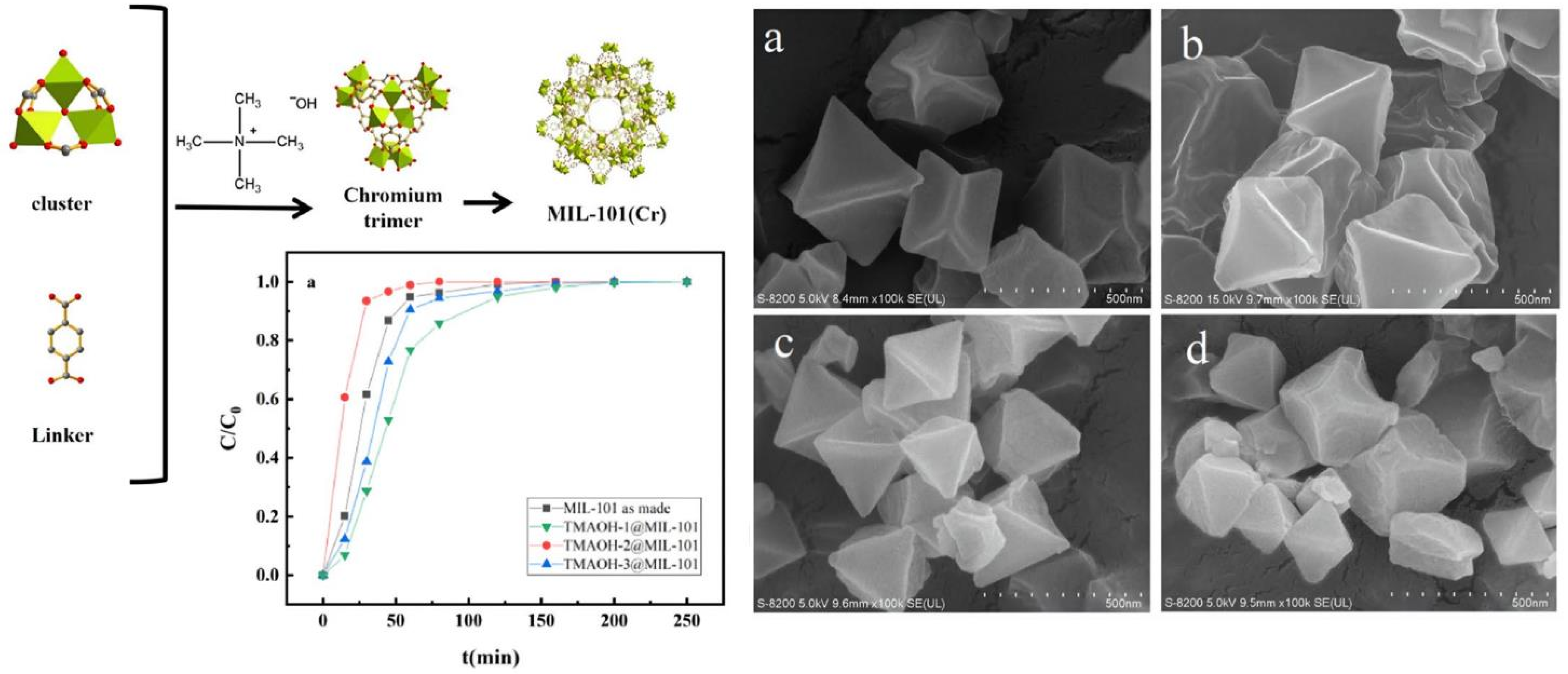

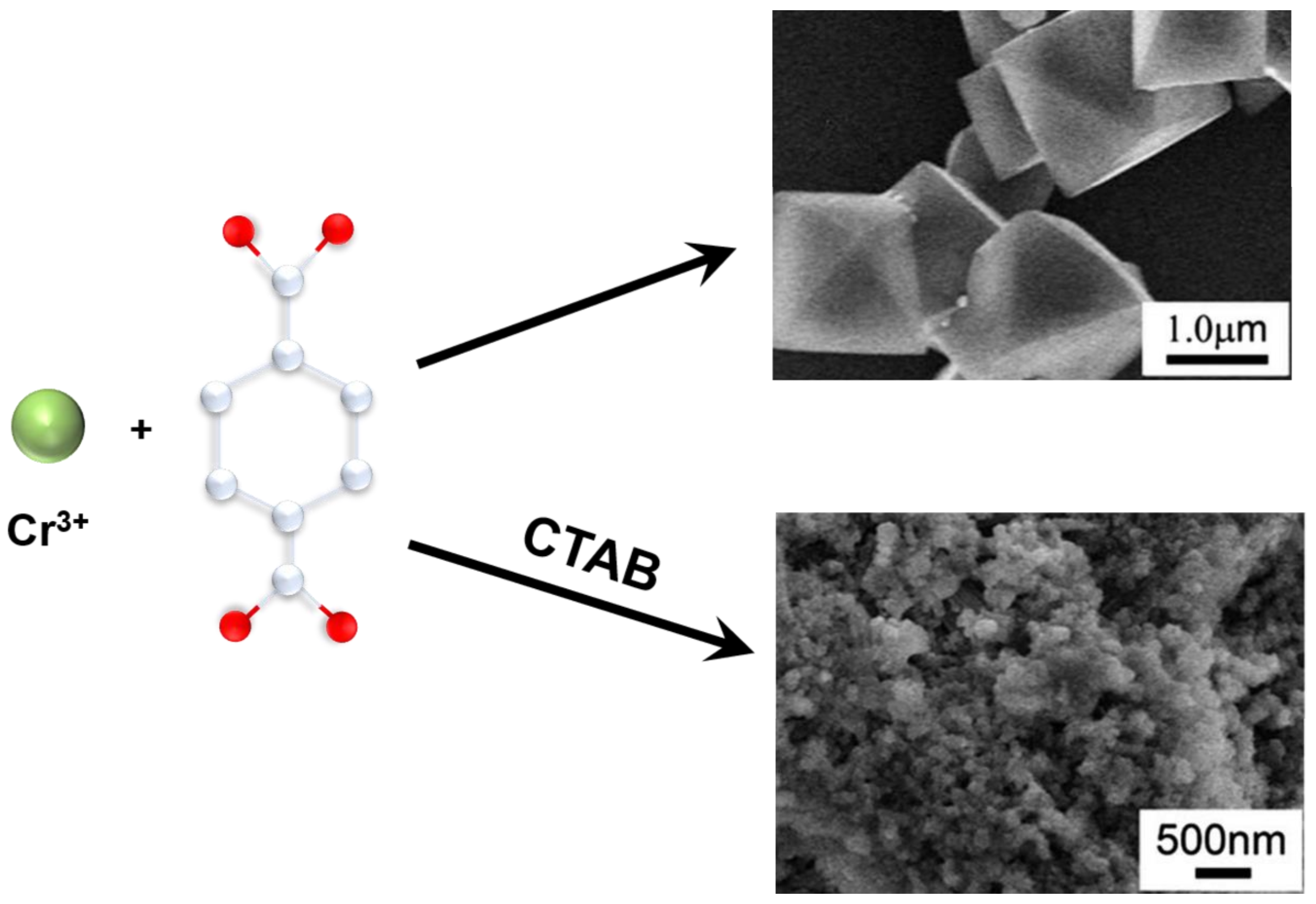
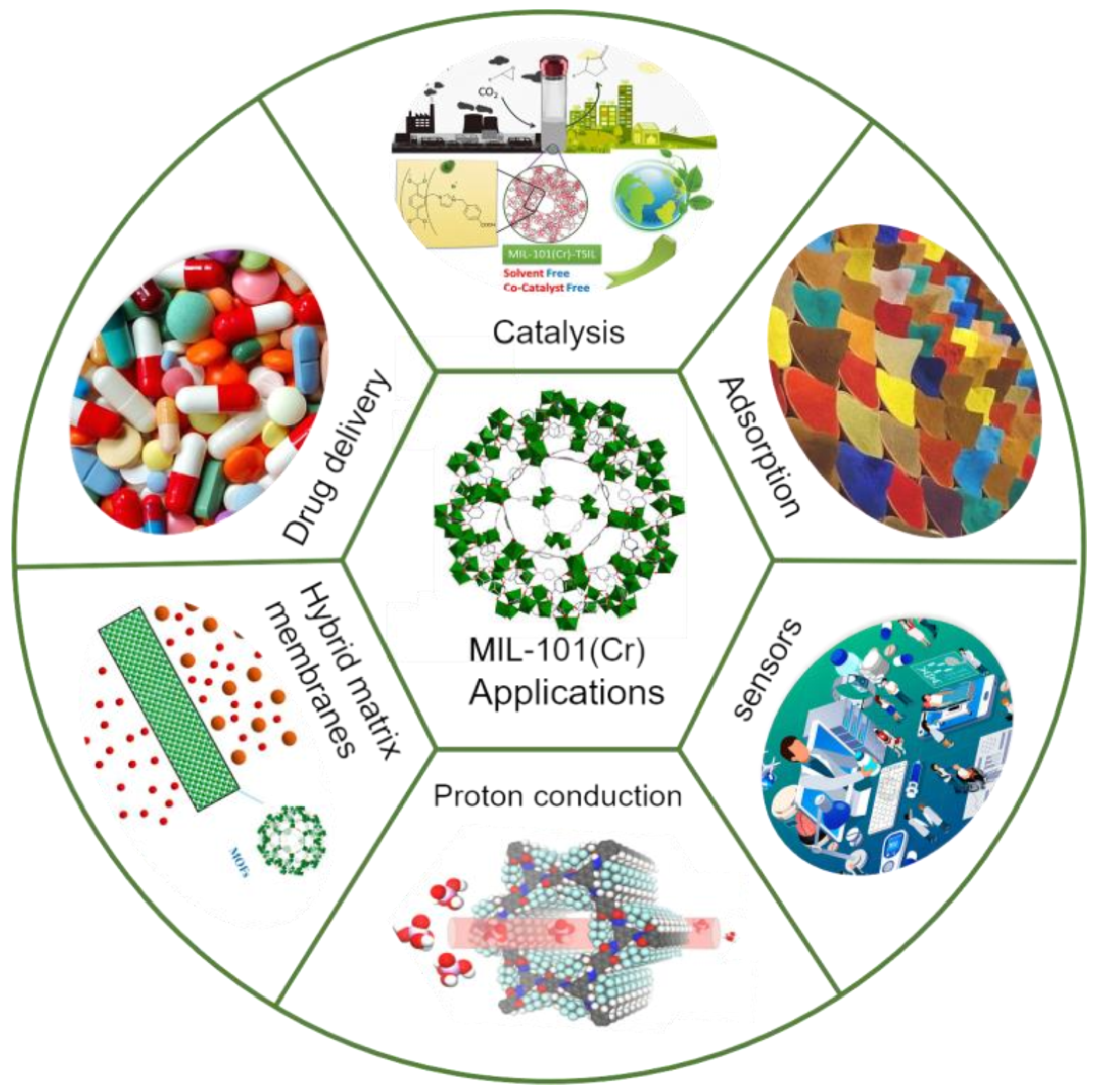
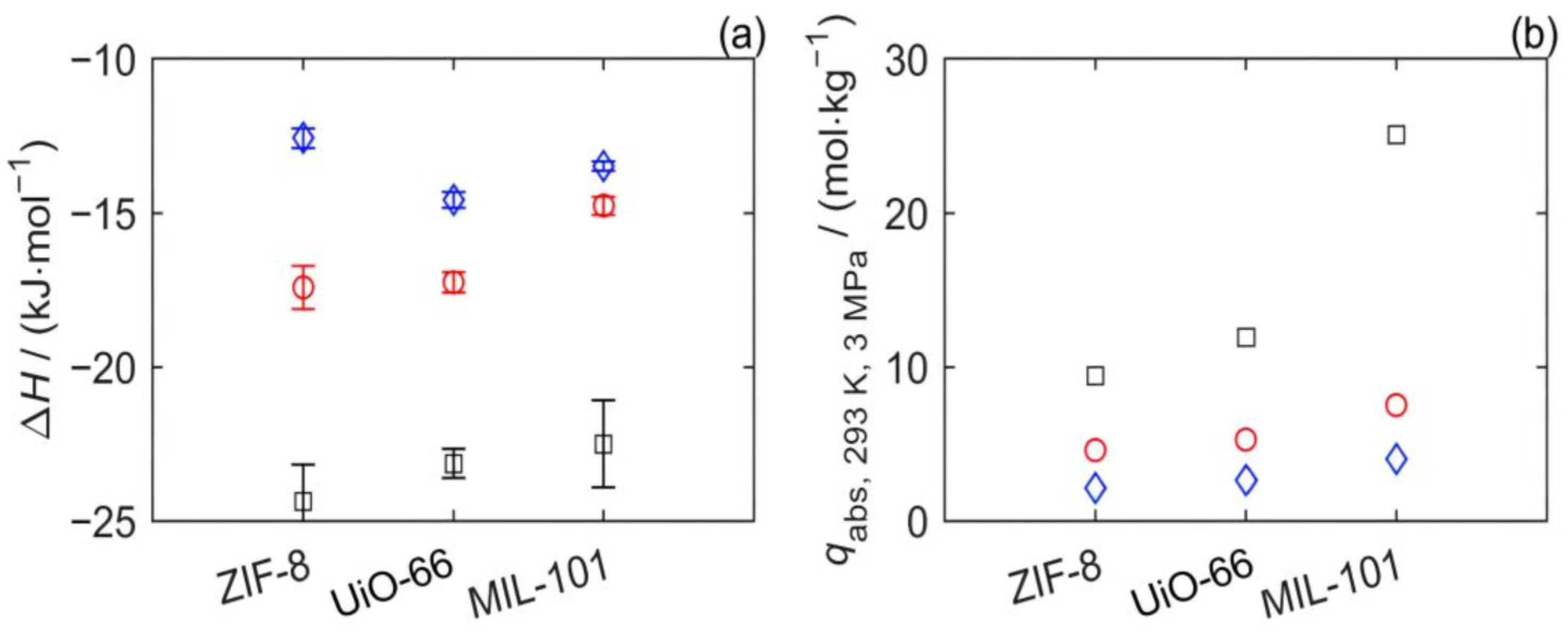
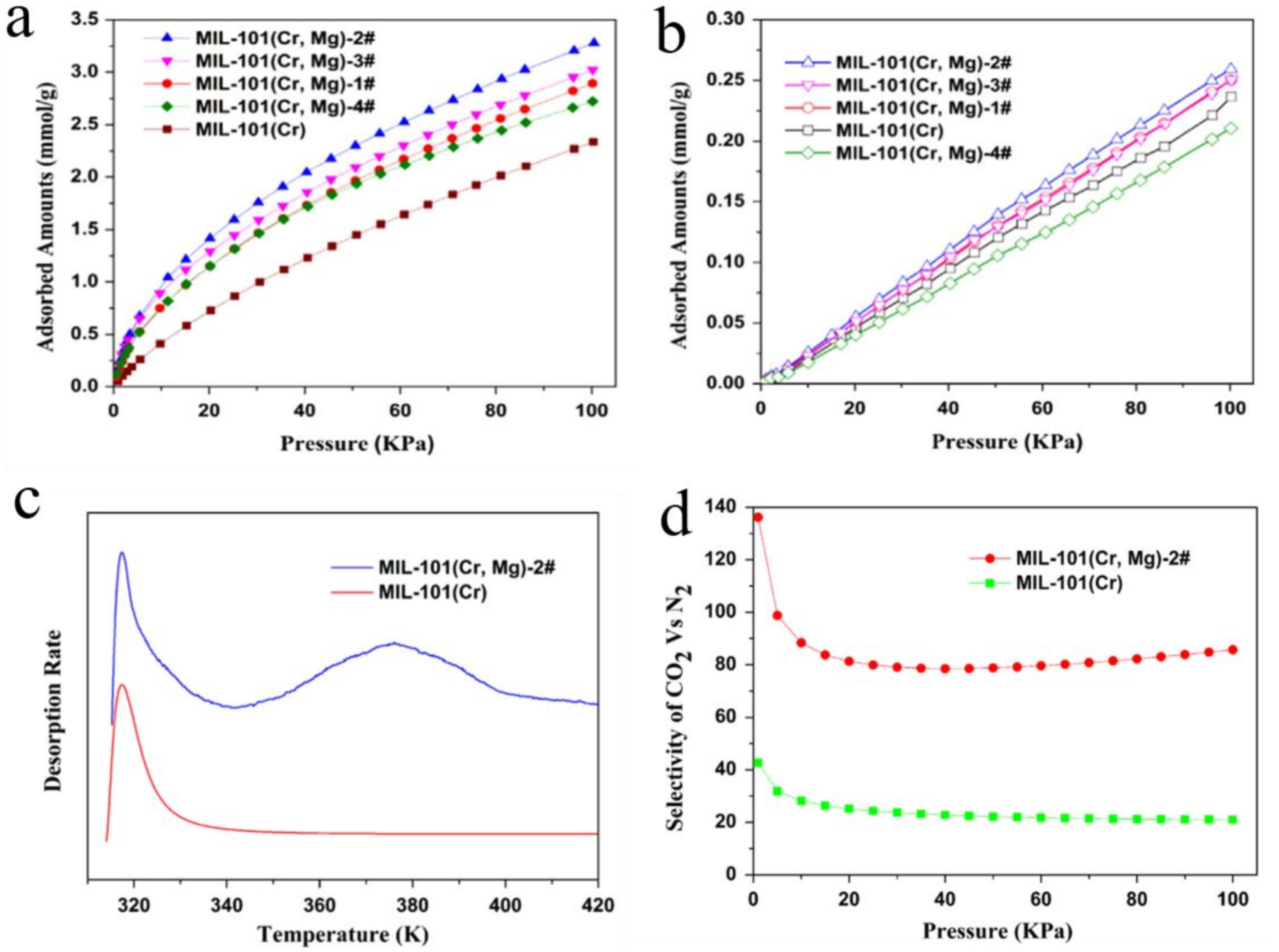
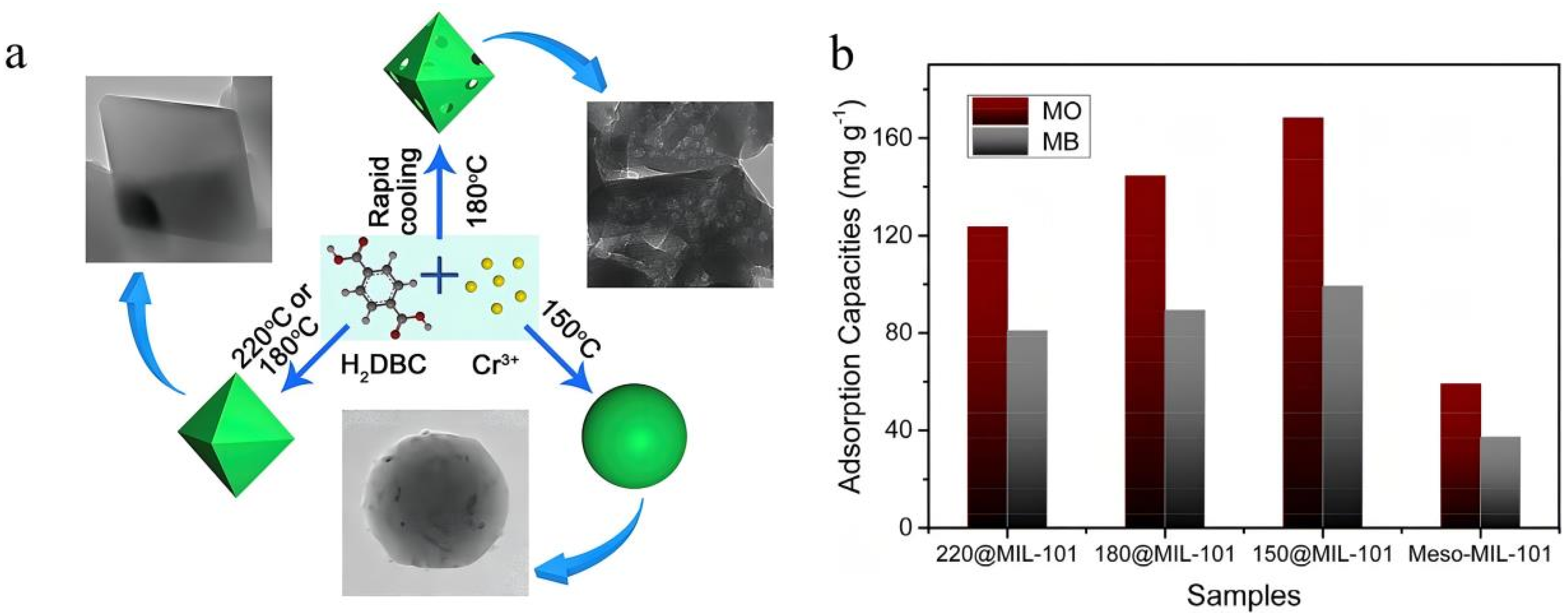
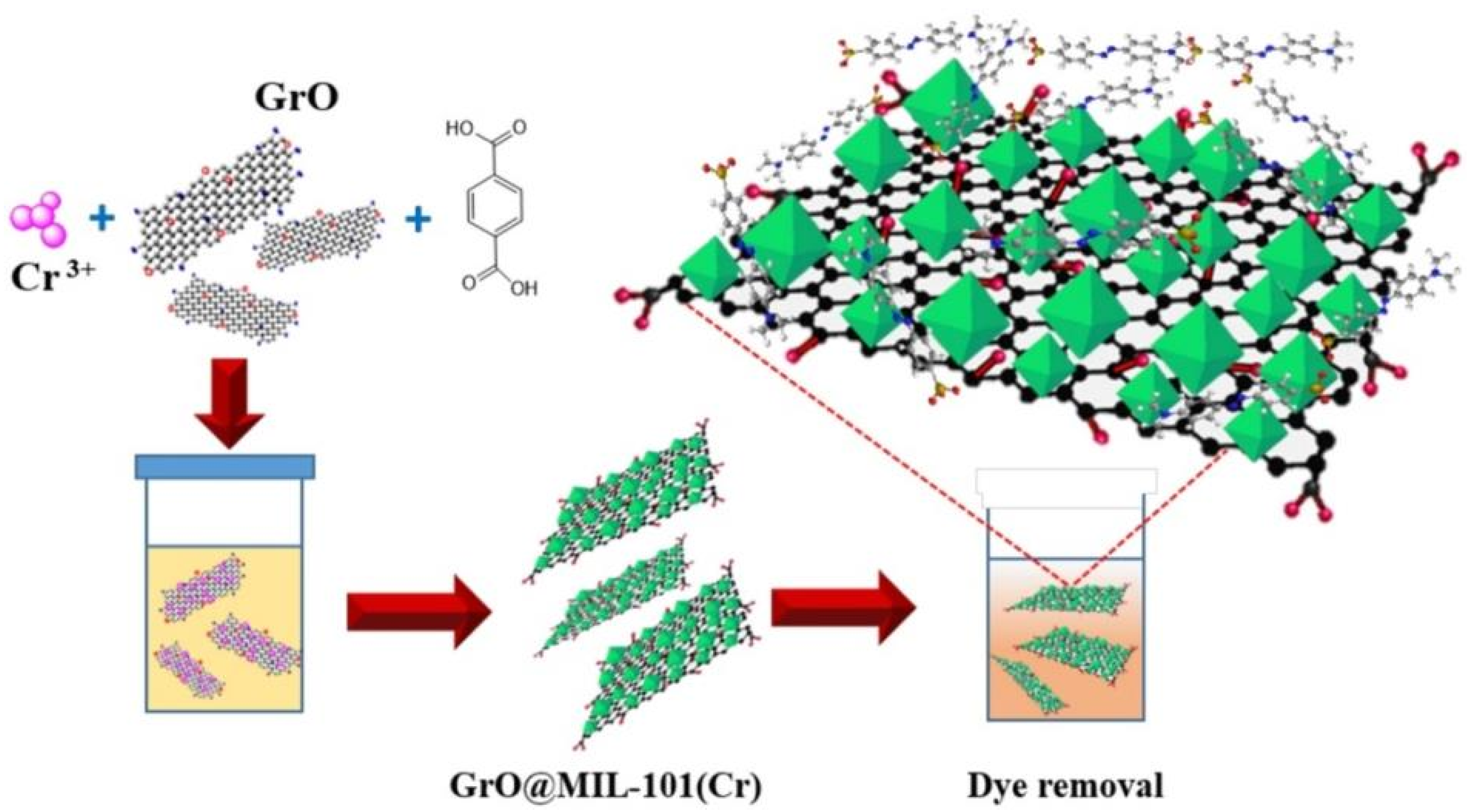

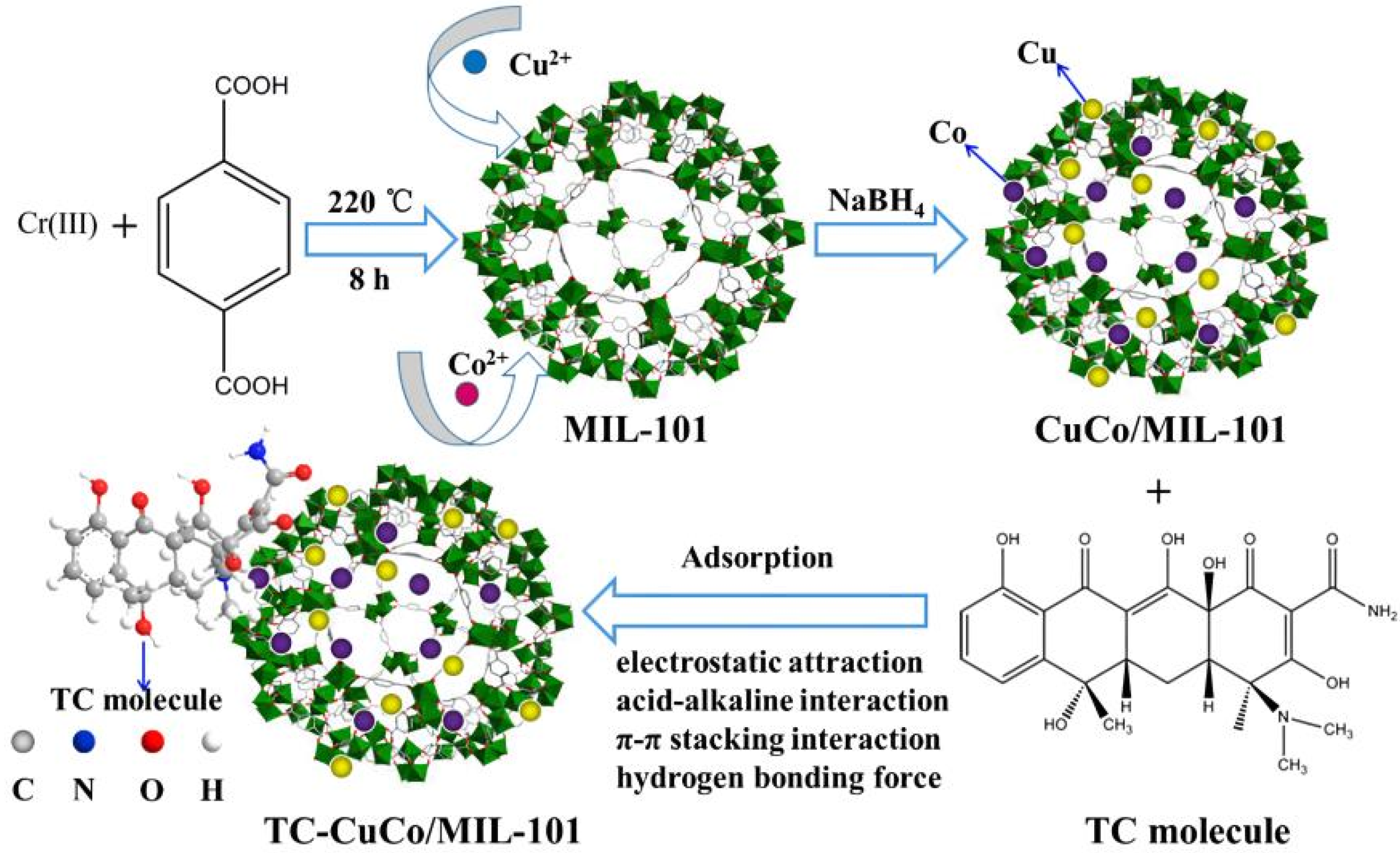

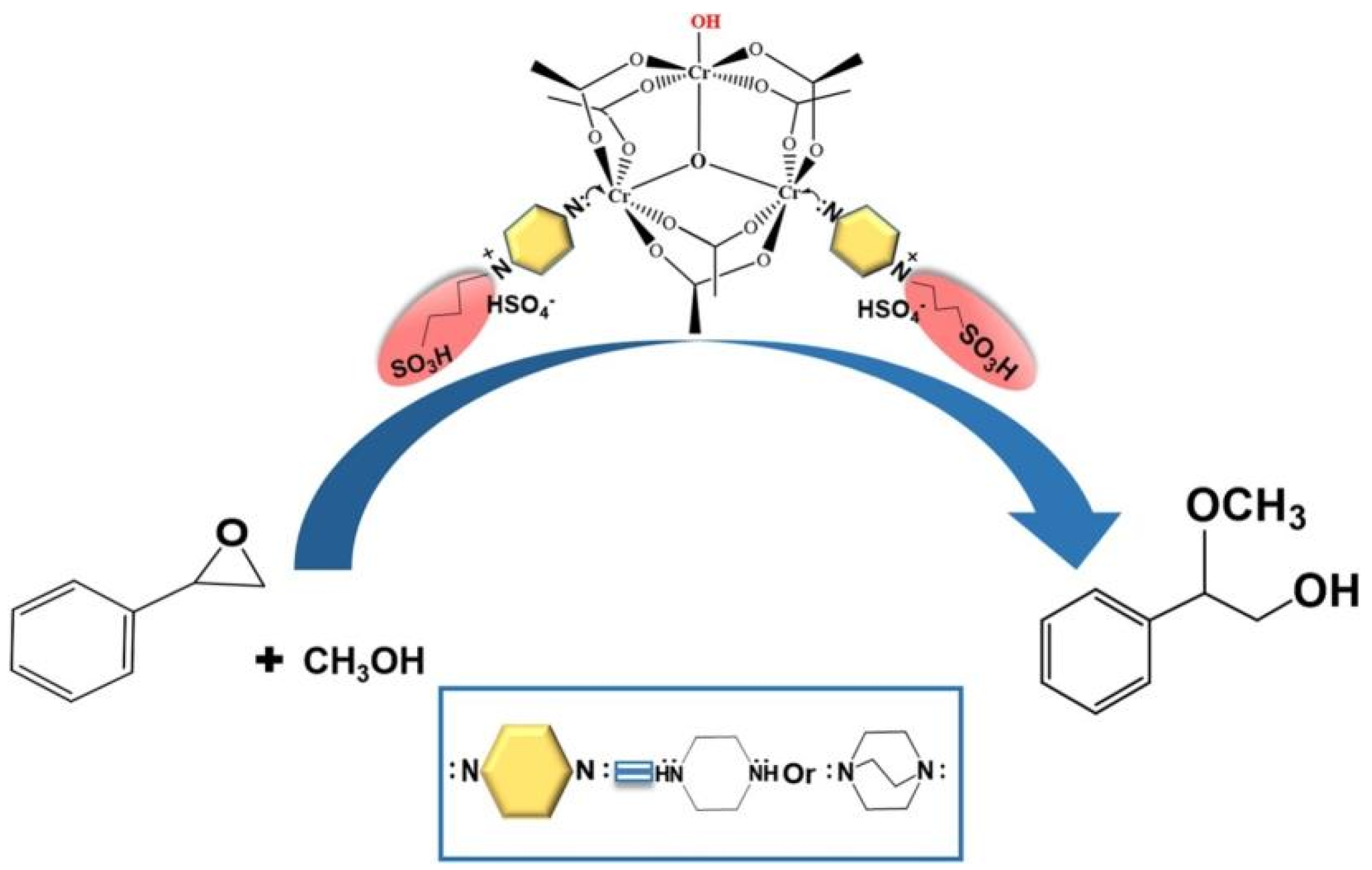


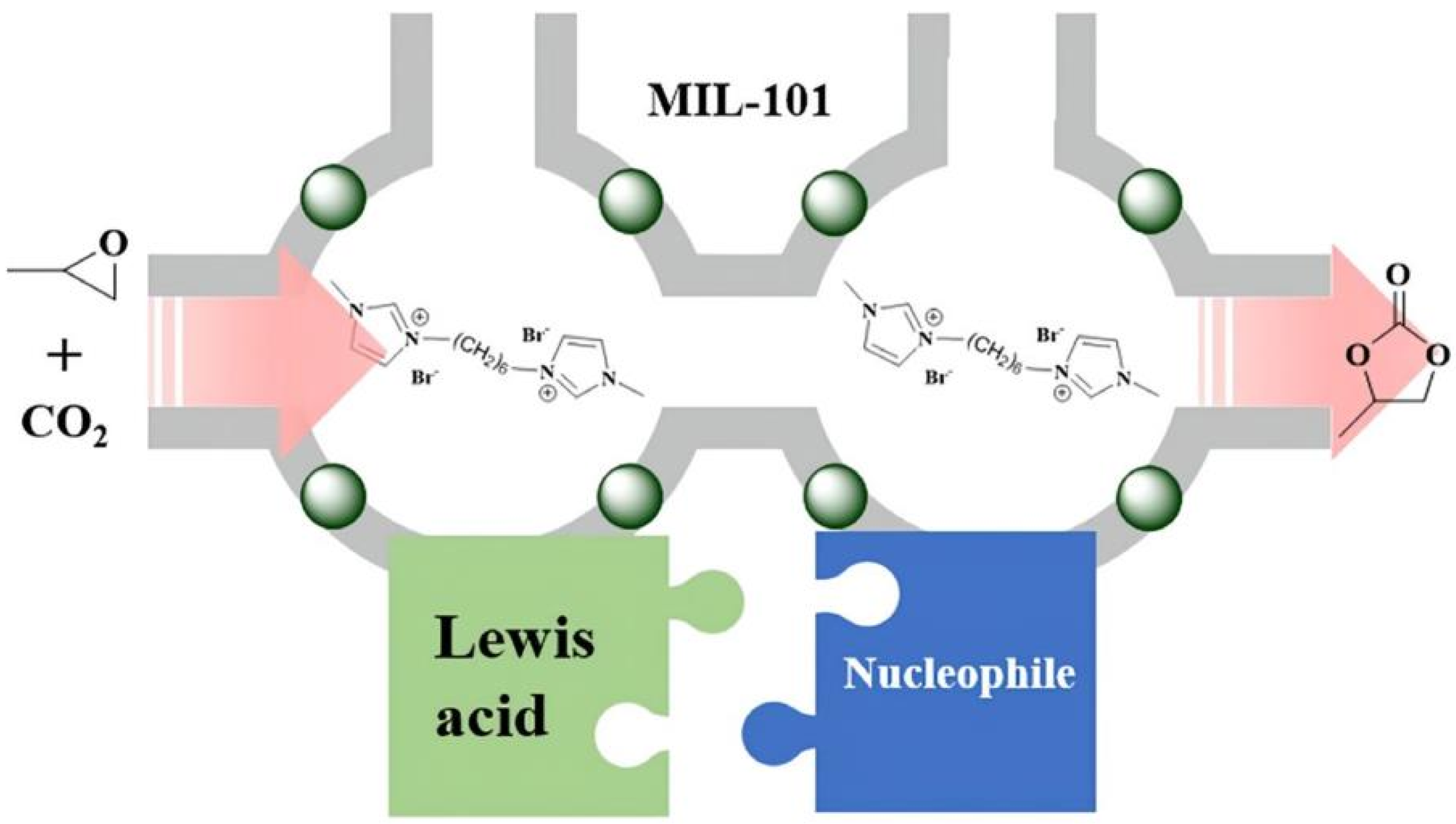



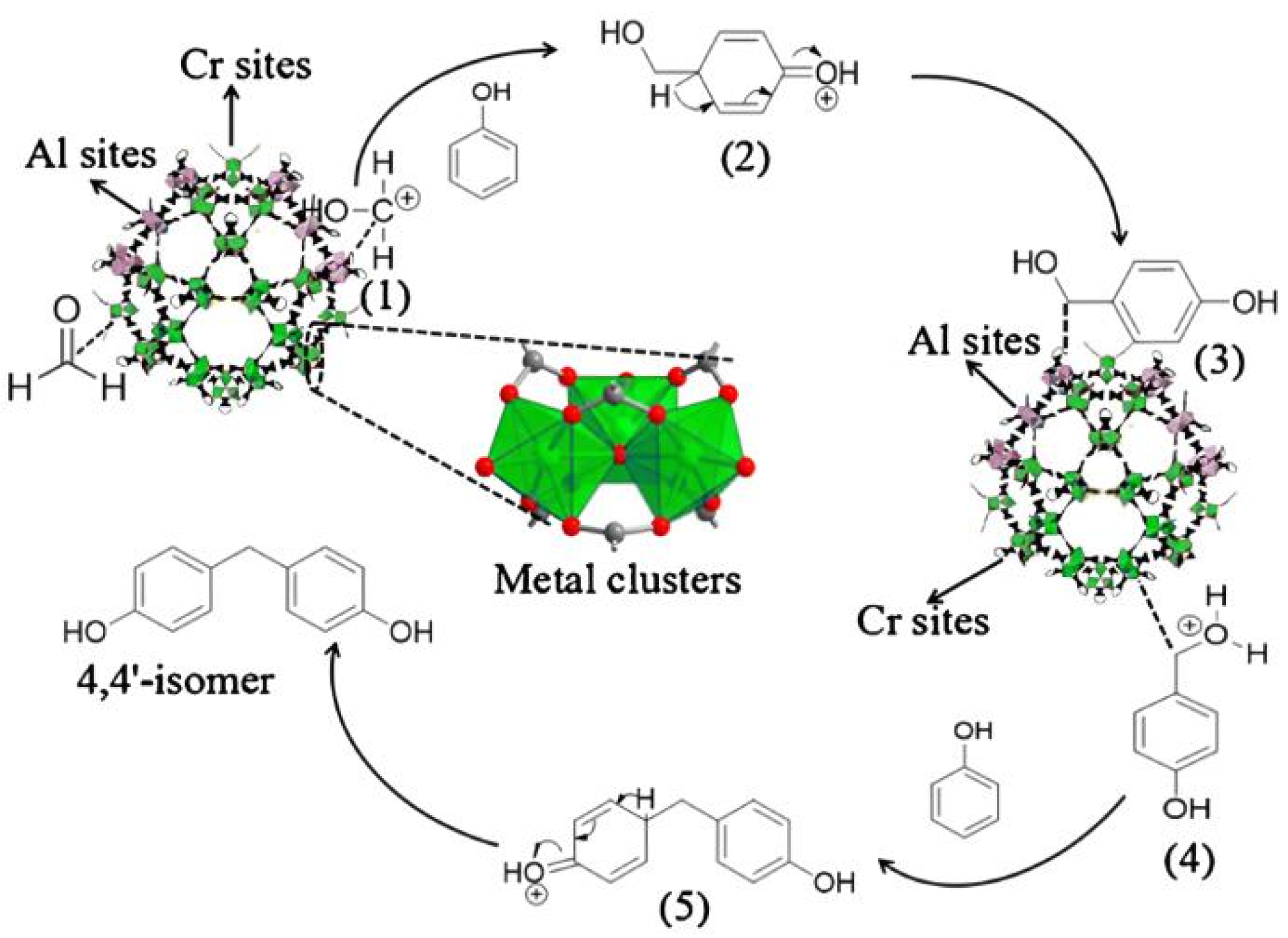
| Method | Synthesis Conditions | Textural Properties | Ref. | |||||
|---|---|---|---|---|---|---|---|---|
| Medium | Time | Temp (°C) | Yield (%) | SBET (m2 g−1) | Vpore (cm3 g−1) | Particle Size (nm) | ||
| Hydrothermal | H2O/HF | 8 h | 220 | 50 | 4100 | 2.02 | / | [18] |
| H2O/HNO3 | 8 h | 220 | 78 | 3841 | 1.72 | 720–2120 | [26] | |
| H2O/NaOH | 8 h | 220 | 47 | 4065 | 2.01 | 87 | [27] | |
| H2O/HNO3 | 8 h | 220 | 81 | 3187 | 1.65 | 1336 | ||
| H2O/HOAc | 8 h | 220 | 53 | 2894 | 1.38 | 141 | ||
| H2O/HCl | 8 h | 220 | / | 3090 | 1.64 | 200–1200 | [28] | |
| H2O/HCOOH | 8 h | 210 | / | 2618 | 1.36 | 100–150 | [29] | |
| H2O/TMAOH | 24 h | 160 | / | 3197 | 1.73 | / | [30] | |
| H2O/CH3COONa | 12 h | 200 | 40 | 1710 | 0.80 | 0.5–1.4 | [31] | |
| H2O/CH3COOH | 8 h | 200 | 55 | 2927 | 1.77 | 1.3–2.1 | ||
| H2O/CH3COOLi | 12 h | 220 | / | 3401 | 1.83 | 480 | [32] | |
| H2O/CH3COOK | 12 h | 220 | / | 3398 | 1.79 | 240 | ||
| Solvothermal | H2O/HF | 96 h | 220 | / | 3780 | 1.74 | / | [33] |
| Mixed-solvothermal | DMF/H2O | 24 h | 160 | 83.3 | 2453.1 | 1.16 | 200 | [34] |
| Microwave (MW) | H2O/HF | 1 h | 220 | / | 3054 | 2.01 | 70–100 | [35] |
| MW-assisted solvo/hydrothermal | H2O | 30 min | 220 | / | 2667 | 1.37 | 100–110 | [36] |
| MV | H2O/HF | 40 min | 210 | / | 3900 | 2.3 | 70–90 | [37] |
| H2O | 15 min | 210 | 36 | 3071 | 1.51 | 200 | [38] | |
| H2O | 1 h | 210 | 38 | 3196 | 1.55 | 200 | ||
| Electric heating (CE) | H2O | 6 h | 210 | 31 | 2735 | 1.43 | 800 | |
| H2O | 24 h | 210 | 42 | 3160 | 1.54 | 400 | ||
| MV | H2O | 10 min | 210 | 29 | 1710.1 | 1.28 | 100 | [39] |
| CE | H2O | 12 h | 210 | 35 | 2284.7 | 1.76 | 400 | |
| MV/CE | H2O | 4 min/12 h | 210 | 41 | 1664.9 | 1.17 | 135 | |
| MV/CE | H2O | 4 min/3 h | 210 | 37 | 1747.6 | 1.35 | 155 | |
| expanded graphite (EG) | H2O/HF | 2 h | 220 | 43 | 3751 | 1.8 | 400 | [40] |
| cetyltrimethylammonium bromide (CTAB) | H2O/HF | 8 h | 220 | / | 638 | 0.51 | 3.25 | [41] |
| CTAB | H2O/HF | 8 h | 220 | / | 1560 | / | 3.91 | [42] |
| CTAB | NaAc | 12 h | 220 | / | 1144 | / | 3.47 | |
| CTAB | H2O/HF | 8 h | 220 | / | 846 | / | 120–250 | [43] |
| Adsorbent | Adsorbate | Temp. (K) | Pressure (bar) | Uptake (mmol g−1) | Ref. |
|---|---|---|---|---|---|
| MIL-101(Cr) | H2 | 77.4 | 45 | 30.4 | [47] |
| MIL-101(Cr) | CO2 | 298 | 1 | 7.7 | [39] |
| MIL-101(Cr) | CO2 | 283 | 30 | 29.4 | [68] |
| MIL-101(Cr) | CH4 | 283 | 30 | 8.6 | |
| MIL-101(Cr) | N2 | 283 | 30 | 4.5 | |
| MIL-101(Cr) | CO2 | 303 | 50 | 40 | [33] |
| MIL-101(Cr) | CH4 | 303 | 60 | 13.6 | |
| MIL-101(Cr) | H2 | 77 | 80 | 30.5 | [69] |
| MIL-101(Cr) | CO2 | 288 | 1.13 | 3.8 | [71] |
| MIL-101(Cr) | CO | 288 | 1.13 | 1.13 | |
| MIL-101(Cr) | CH4 | 288 | 1.13 | 0.58 | |
| MIL-101(Cr) | N2 | 288 | 1.13 | 0.31 | |
| MIL-101(Cr) | CO2 | 298 | 7 | 9.7 | [72] |
| MIL-101(Cr) | CO2 | 298 | 1 | 18.8 | [73] |
| MIL-101(Cr) | H2 | 77.3 | 80 | 43.5 | [74] |
| MIL-101(Cr) | H2 | 293 | 1900 | 36 | [75] |
| MIL-101(Cr) | CO2 | 298 | 6 | 2.3 | [76] |
| MIL-101(Cr) | CO2 | 298 | 0.1 | 0.49 | [77] |
| MIL-101(Cr) | HF | 288 | 1 | 11.4 | [78] |
| MIL-101(Cr) | N2O | 298 | 1 | 5.5 | [79] |
| MIL-101(Cr) | CO2 | 298 | 1 | 5.4 | |
| MIL-101(Cr) | N2 | 298 | 1 | 0.76 | |
| MIL-101(Cr) | CO2 | 298 | 1 | 1.2 | [80] |
| MIL-101(Cr) | CO2 | 298 | 10 | 11.2 | |
| MIL-101(Cr) | CO2 | 298 | 25 | 13.1 | |
| MIL-101(Cr) | SO2 | 298 | 0.01 | 1.5 | [81] |
| Mmen-MIL-101(Cr) | SO2 | 298 | 0.01 | 3.0 | |
| MIL-101(Cr) | CO2 | 298 | 25 | 14.6 | [82] |
| GrO@ MIL-101(Cr) | CO2 | 298 | 25 | 22.4 | |
| MIL-101(Cr) | CO2 | 298 | 0.15 | 0.7 | [83] |
| MIL-101(Cr) | CO2 | 298 | 1 | 2.6 | |
| PANI@MIL-101(Cr) a | CO2 | 298 | 0.15 | 1.7 | |
| PANI@MIL-101(Cr) | CO2 | 298 | 1 | 3.9 | |
| MIL-101 (Cr)-PEI b | CO2 | 348 | 1 | 3.81 | [84] |
| MIL-101(Cr)-NH2 | CO2 | 278 | 1 | 5.4 | [85] |
| MIL-101(Cr)@MCM-41 | CO2 | 297 | 1 | 2.1 | [86] |
| PEI/MIL-101(Cr) | CO2 | 273 | 0.15 | 4.2 | [87] |
| MIL-101(Cr) | CO2 | 298 | 0.05 | 28.65 | [88] |
| MIL-101(Cr) | CH4 | 298 | 0.02 | 11.02 | |
| MIL-101(Cr) | MeSH | 298 | 14.9 | 24.54 | |
| MIL-101(Cr)@CO 5wt% | CO2 | 298 | 0.05 | 32.19 | |
| MIL-101(Cr)@CO 5wt% | CH4 | 298 | 0.02 | 12.59 | |
| MIL-101(Cr)@CO 5wt% | MeSH | 298 | 9.32 | 32.3 | |
| MIL-101(Cr) | NH3 | 298 | 1 | 8.92 | [89] |
| IL@MIL-101(Cr) | NH3 | 298 | 1 | 24.12 | |
| MIL-101(Cr)@M-0.5-0.5 c | CO2 | 298 | 1 | 3.16 | [90] |
| MIL-101(Cr)@M-0.5-0.5 | H2S | 298 | 1 | 7.63 |
| Adsorbent | Dyes | Uptake (mg g−1) a | Ref. |
|---|---|---|---|
| MIL-101(Cr) | Methyl orange | 369.8 | [101] |
| MIL-101(Cr) | Xylenol orange | 307 | [102] |
| MIL-101(Cr) | Methyl orange | 87.5 | [103] |
| MIL-101(Cr) | Congo red | 1223.6 | [104] |
| MIL-101(Cr) | Methyl orange | 475.3 | |
| MIL-101(Cr) | Direct red 80 | 227 | [105] |
| MIL-101(Cr) | Acid blue 92 | 185 | |
| MIL-101(Cr) | Methyl orange | 102 | [106] |
| MIL-101(Cr) | Reactive blue 198 | 88 | |
| MIL-101(Cr) | Methylene blue | 4.24 | [42] |
| HP-MIL-101(Cr) | Methylene blue | 11.23 | |
| MIL-101(Cr) | Methyl orange | 217.85 | |
| HP-MIL-101(Cr) | Methyl orange | 205.28 | |
| 150@MIL-101(Cr) | Methyl orange | 420.2 | [107] |
| 180@MIL-101(Cr) | Methyl orange | 327.9 | |
| 220@MIL-101(Cr) | Methyl orange | 246.9 | |
| Meso-MIL-101(Cr) | Methyl orange | 110.7 | |
| Spherical-MIL-101(Cr) | Methyl orange | 444.3 | [108] |
| Spherical-MIL-101(Cr) | Rhodamine B | 230.3 | |
| MIL-101(Cr) | Methyl orange | 114 | [99] |
| ED-MIL-101(Cr) b | Methyl orange | 160 | |
| PED-MIL-101(Cr) b | Methyl orange | 194 | |
| MIL-101(Cr) | Fluorescein sodium | 297.5 | [109] |
| MIL-101(Cr) | Safranine T | 113.8 | |
| MIL-101(Cr)-SO3H | Fluorescein sodium | 70.8 | |
| MIL-101(Cr)-SO3H | Safranine T | 425.5 | |
| MIL-101(Cr) | Direct red 31 | 382.72 | [110] |
| MIL-101(Cr) | Acid blue 92 | 335.76 | |
| AC@MIL-101(Cr) c | Direct red 31 | 397.64 | |
| AC@MIL-101(Cr) | Acid blue 92 | 372.0 | |
| MIL-101(Cr)-COOH-1 | Congo red | 2835.7 | [111] |
| MIL-101(Cr)-COOH-1 | Methyl orange | 473.9 | |
| MIL-101(Cr)-COOH-1 | Acid chrome blue K | 240.8 | |
| MIL-101(Cr) | Acid chrome blue K | 323.1 | |
| MIL-101(Cr)-SO3H-1 | Methyl orange | 688.9 | [112] |
| MIL-101(Cr) SO3H-1 | Congo red | 2592.7 | |
| MIL-101(Cr)-SO3H-1 | Acid chrome blue K | 213.2 | |
| MIL-101(Cr)-NH2 | Congo red | 2967.1 | [113] |
| MIL-101(Cr)-NH2 | Methyl orange | 461.7 | |
| MIL-101(Cr)-NH2 | Acid chrome blue K | 259.8 | |
| Ni(II)-doped MIL-101(Cr) | Congo red | 1607.4 | [114] |
| Ni(II)-doped MIL-101(Cr) | Methyl orange | 651.2 | |
| Ni(II)-doped MIL-101(Cr) | Acid chrome blue K | 161.0 | |
| NH2-MIL-101(Cr) | Direct blue 80 | 521 | [115] |
| NH2-MIL-101(Cr) | Acid blue 1 | 455 | |
| NH2-MIL-101(Cr) | Rhodamine B | 232 | |
| NH2-MIL-101(Cr) | Methylene blue | 33 | |
| MIL-101(Cr)/GA d | Methyl orange | 331.5 | [116] |
| MIL-101(Cr)/GA | Rhodamine B | 345.7 | |
| MIL-101(Cr) | Methyl orange | 143.4 | [117] |
| TiO2/MIL-101(Cr) | Methyl orange | 186.1 |
| Adsorbent | Drug | Uptake (mg g−1) | Ref. |
|---|---|---|---|
| MIL-101(Cr) | sulfamethoxazole | 181.82 | [118] |
| MIL-101(Cr) | propiconazole | 89.78 | [119] |
| MIL-101(Cr) | diazinon | 260.43 | [120] |
| MIL-101(Cr) | 4-chloro-2-methylphenoxyacetic acid | 233.576 | [121] |
| MIL-101(Cr) | 3,6-dichloro-2-methoxy benzoic acid | 237.384 | [122] |
| MIL-101 | Naproxen | 114 | [123] |
| MIL-101-OH | Naproxen | 185 | |
| MIL-101-(OH)2 a | Naproxen | 136 | |
| MIL-101-NH2 | Naproxen | 147 | |
| MIL-101-NO2 | Naproxen | 66.1 | |
| MIL-101(20) b | Indomethacin sodium | 641 | [124] |
| MIL-101(Cr) | Ciprofloxacin | 113.2 | [125] |
| MIL-101(Cr)-HSO3 | Ciprofloxacin | 564.9 | |
| MIL-101(Cr) | Naproxen | 112 | [126] |
| MIL-101(Cr)-GnO(3%) c | Naproxen | 155 | |
| MIL-101(Cr)-GnO(3%) | Naproxen | 171 | |
| MIL-101(Cr)@GO d | Sulfamethoxazole | 101.01 | [127] |
| MIL-101(Cr)@GO | Sulfadiazine | 135.14 | |
| MIL-101(Cr)@GO | Sulfadoxine | 119.05 | |
| CuCo/MIL-101 | Tetracycline | 225.179 | [128] |
| MIL-101 | Naproxen | 131 | [129] |
| AMSA-MIL-101 e | Naproxen | 93 | |
| ED-MIL-101 f | Naproxen | 154 | |
| MIL-101 | Clofibric acid | 315 | |
| AMSA-MIL-101 | Clofibric acid | 105 | |
| ED-MIL-101 | Clofibric acid | 347 | |
| MIL-101(Cr)@AC g | Sulfacetamide | 166.11 | [130] |
| Urea-MIL-101(Cr)@AC | Sulfacetamide | 231.2 | |
| nZVI/MIL-101(Cr) h | Tetracycline | 625.0 | [131] |
| MIL-101(Cr)/Fe3O4 | Ciprofloxacin | 63.28 | [132] |
| Catalyst | Reaction | TOF (min−1) a | Conversion (%) | Ref. |
|---|---|---|---|---|
| MIL-101(Cr) | Cyclohexene Oxidation | 1.70 | / | [45] |
| MIL-101(Cr) | Cyclohexene Oxidation | 1.31 | / | |
| MIL-101(Cr) | Cyclohexene Oxidation | 1.29 | / | |
| HP-MIL-101(Cr) b | Indene oxidation reaction | 1.67 | 83 | [100] |
| HP-MIL-101(Cr) | 1-Dodecene oxidation reaction | 0.31 | 92 | |
| HP-MIL-101(Cr)@PTA c | Methanolysis of styrene oxide | 7.59 | 72 | |
| HP-MIL-101(Cr)@PTA | Dibenzoxanthene synthesis | 18.9 | 90 | |
| HP-MIL-101(Cr)@PTA | 1-(N-acetylaminophenylmethyl)-2-naphthole | 45.9 | 91 | |
| CuPc@MIL 101(Cr) | Styrene epoxidation | / | 100 | [141] |
| MIL-101(Cr) | Cyanosilylation of benzaldehyde | / | 96 | [142] |
| MIL-101(Cr)-NH2-SF d | Henry reaction | / | 95 | [143] |
| MIL-101(Cr)-NH2 | Henry reaction | / | 79 | |
| MIL-101(Cr) | Hydroxyalkylation of phenol with formaldehyde | / | 5.9 | [144] |
| MIL-101(Cr/Al) | Hydroxyalkylation of phenol with formaldehyde | / | 88.7 | |
| 3.0%-Ag@MIL101(Cr) | One-pot imine synthesis from alcohols and amines | / | 99 | [145] |
| S/MIL-101(Cr) e | Esterification of acetic acid with n-butano | 0.57 | / | [146] |
| S/MIL-101(Cr) | Esterification of acetic acid with n-hexanol | 1.07 | / | |
| S-MIL-101(Cr) f | Esterification of acetic acid with n-butano | 1.18 | / | |
| S-MIL-101(Cr) | Esterification of acetic acid with n-hexanol | 2.78 | / | |
| MIL-101(Cr) | Acetaldehyde-Phenol condensation | 0.18 | / | [147] |
| MIL-101(Cr)/PTA | Acetaldehyde-Phenol condensation | 17 | / | |
| 50%Ti-MIL-101-550 g | oxidative desulfurization reaction of dibenzothiophene | / | 90 | [148] |
| 1% Pd/PTA-MIL | CO oxidation | 19 | / | [149] |
| 3% Pd/PTA-MIL | CO oxidation | 6.34 | / | |
| 3%Pt3%Co/MIL-101(Cr) | Hydrogenation of cinnamaldehyde | 9.1 | / | [150] |
| MIL-101(Cr/Fe) (4:1) | Prins reaction | / | 85 | [151] |
| Ag20Pd80@MIL-101 | formic acid hydrolysis reaction | 14.13 | / | [152] |
Publisher’s Note: MDPI stays neutral with regard to jurisdictional claims in published maps and institutional affiliations. |
© 2022 by the authors. Licensee MDPI, Basel, Switzerland. This article is an open access article distributed under the terms and conditions of the Creative Commons Attribution (CC BY) license (https://creativecommons.org/licenses/by/4.0/).
Share and Cite
Zou, M.; Dong, M.; Zhao, T. Advances in Metal-Organic Frameworks MIL-101(Cr). Int. J. Mol. Sci. 2022, 23, 9396. https://doi.org/10.3390/ijms23169396
Zou M, Dong M, Zhao T. Advances in Metal-Organic Frameworks MIL-101(Cr). International Journal of Molecular Sciences. 2022; 23(16):9396. https://doi.org/10.3390/ijms23169396
Chicago/Turabian StyleZou, Minmin, Ming Dong, and Tian Zhao. 2022. "Advances in Metal-Organic Frameworks MIL-101(Cr)" International Journal of Molecular Sciences 23, no. 16: 9396. https://doi.org/10.3390/ijms23169396
APA StyleZou, M., Dong, M., & Zhao, T. (2022). Advances in Metal-Organic Frameworks MIL-101(Cr). International Journal of Molecular Sciences, 23(16), 9396. https://doi.org/10.3390/ijms23169396






